
Despite what those wine snobs like to believe, no one can know ALL there is to know about wine. But that’s part of the beauty of this expansive topic! And if you’re new to wine, I appreciate how daunting it can be knowing exactly where to “jump in.” So if you find yourself in this vinous quandary, I'm happy to help with the perfect starting point - my two companion blog posts: White Wine 101 which I posted last week and this week’s post, Red Wine 101!
Beginning with the basics is always a great way to start and after reading these two posts you'll know:
The important differences between white and red wine production
The most popular grape varieties you'll encounter on wine lists and at your local wine or grocery store
Which well-known producers to look for when shopping for a particular grape variety or style of wine
Delicious food pairing suggestions and recipes
Helpful lingo that'll have you "Talking the Talk" of both red and white wine in no time!

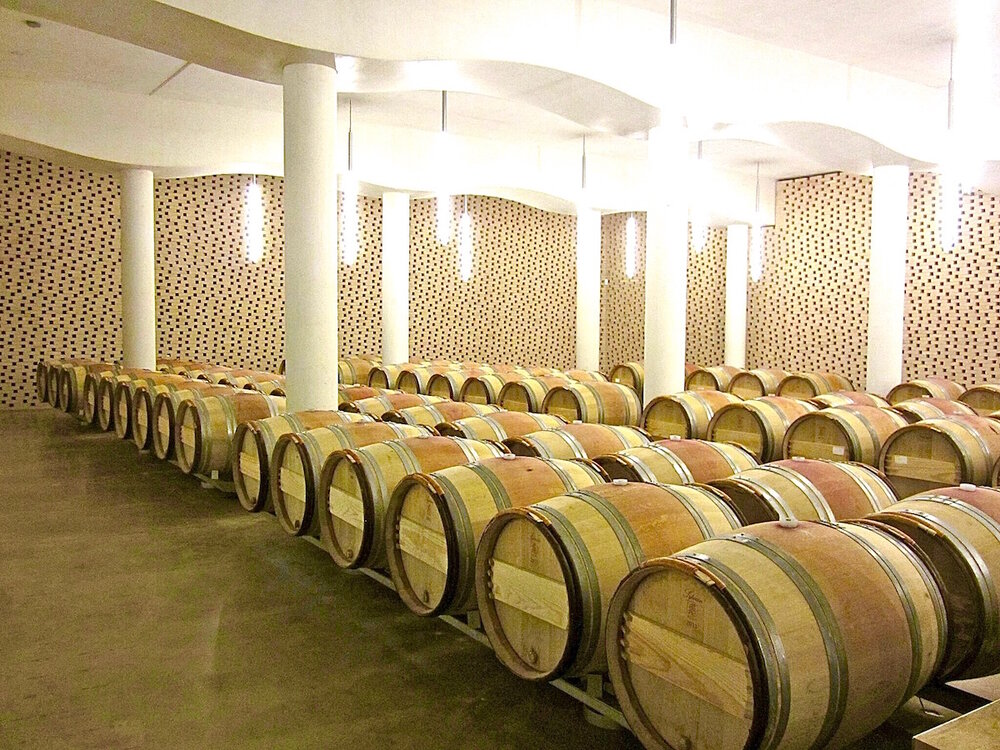
Before we dive in, I wanted to debunk some commonly held misconceptions about red wine:
Only about 3-5% of ALL wine produced improves with age so do NOT think you have to wait for all red wines to "age" before you drink them. But how can you tell if a red wine is an age-worthy one? If the wine is sealed with a screwcap, and/or falls within the $25 and under price category, go ahead and drink away. Red wines intended for aging are usually $35 and over and are generally always sealed with a cork to allow oxygen transfer to occur.
Removing the cork of a wine from a wine bottle does NOT allow a red wine to “breathe” and will do nothing to help it "open up." The only way to do this is to decant the wine, a process in which the liquid is infused with oxygen by pouring it from the bottle into a decanting vessel such as a crystal wine decanter (recommended) or a flower vase. For more on the benefits of decanting and how it's performed, please scroll down to "Talking the Talk."
If you suffer from the dreaded Red Wine Headache (RWH), it is NOT the sulfites that's causing them! White wine has almost twice the sulfites of red wine and while there's still some debate as to which exact chemical causes them, you have a better chance of avoiding these headaches by opting for lighter-bodied, lower tannin red wines like Pinot Noir or Gamay which contain lower amounts of these chemical suspects.

As I mentioned in White Wine 101, before we get into the differences between white wine and red wine, let's talk about what they have in common first, namely: fermentation! Please check out my previous post for more on this simple, yet critical chemical process. While white and red wines do have fermentation in common, red wine differs from white wine in a few important ways:
MACERATION: This is perhaps the major defining difference between white and red winemaking. In white winemaking there's essentially no contact between the grape juice and the skins, a process called maceration. However in red wine production, maceration is the manner by which important phenolic compounds are infused into the wine through contact with grape skins, stems and seeds. These compounds which include tannins and anthocyanins are responsible for a red wine’s color, flavor profile and mouthfeel. The duration of maceration is determined by the winemaker depending on the style of wine he is trying to make.
GRAPE VARIETIES: Since the color of red wine is largely determined by the color of the grapes used to make it, red wine is generally made using only red grape varieties. The more intense the color of the grape, the more intense the flavor and color of the finished wine. White wine on the other hand, is made from white grapes, and while it is possible to make white wine from red grapes, this process is usually only reserved for sparkling wine production. For more on that, please check out this post.
WARMER FERMENTATION: Unlike white wines which undergo cooler, temperature-controlled fermentations which run around 50-60 degrees, red wine fermentation run much warmer at approximately 60-95 degrees. The warmer temperature facilitates the extraction of color, tannin and other beneficial phenolic compounds which are important in the finished red wine.
MALOLACTIC FERMENTATION: While we hear about this secondary fermentation being used in the production of buttery Chardonnays, it is actually crucial to the production of most red wines as well. During this process, lactic bacteria converts harsh, bitter, malic acid into creamy, buttery lactic acid which makes the wine more palatable and imparts a richer, creamier mouthfeel. So the next time you pop the cork (or screwcap) off a bottle of Australian Shiraz and smell buttered popcorn, now you'll know why!

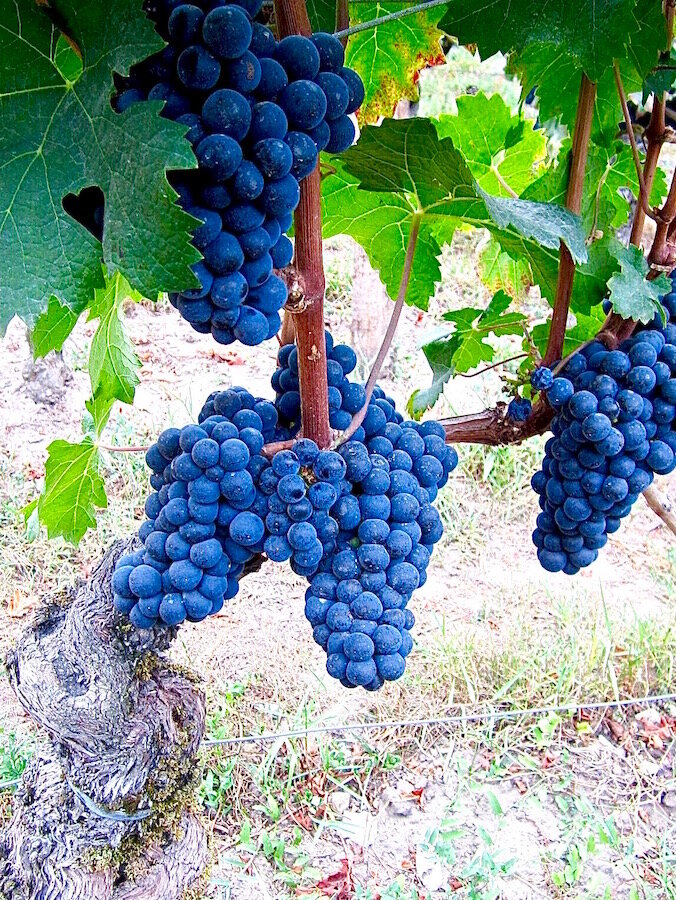
Stylistically speaking, red wines can range from light and fruity to full-bodied and tannic. This largely depends on the grape variety used to make the wine, as well as where the grapes were grown. Below are the top 5 red “cornerstone” grape varieties you're most likely to encounter on restaurant wine lists as well as in your local retail or grocery store. I’ve included information about each grape’s hallmark flavor profile, which foods you should pair them with and a few of my favorite bottles to try. And always remember, if you can’t find the exact wines listed, be sure to ask someone at your local wine shop to suggest a similar alternative:
1.) PINOT NOIR (Burgundy, California, Oregon): This delightful, yet difficult to grow grape variety produces lighter-bodied red wines that are velvety and delicious with notes of cherries, raspberries, earth and spice. It is the legendary grape of France's famed Burgundy wine region, but it also does well in California and Oregon as well. Since Pinot Noir is infamously finicky and a challenge to produce, this is one grape variety where you might want to spend a little more money to get a good bottle. If you’re in the mood to splurge, Pinot’s the place to do it:
PAIR WITH: Pinot Noir is one of the most versatile food pairing grapes on the planet. This is largely due to it's fruity flavor profile, lighter body and friendly, supple tannins. For that reason it pairs brilliantly with dishes ranging from grilled fish to a Burgundian classic like Coq au Vin. It also pairs nicely with difficult to match veggies like Brussels sprouts, beets and broccoli rabe.
GG FAVE PINOT NOIRS (please click on name of wine for purchasing information):
2.) MERLOT (Bordeaux, California, Italy): Since falling from grace in 2004 as a result of Mile's “Merlot-phobia” in the movie "Sideways," I'm happy to report Merlot has officially made a comeback! And why shouldn't it? Merlot is SO easy to love with its lush, plush notes of dark, ripe fruit and uber-alluring tannins. And while it originated in Bordeaux, France where it is still the most widely planted grape today, Merlot performs well in many exciting wine making regions around the world. So if you prefer bold red wines with oodles and fruit and firm, yet supple tannins, it's time to give Merlot another try!
PAIR WITH: Merlot is a lush, full-bodied red wine with lots of ripe fruit which make it perfect for pairing with savory, flavorful fare like burgers and BBQ as well as more refined dishes like seared duck breast with blackberry gastrique and roast leg of lamb.
GG FAVORITE MERLOTS:
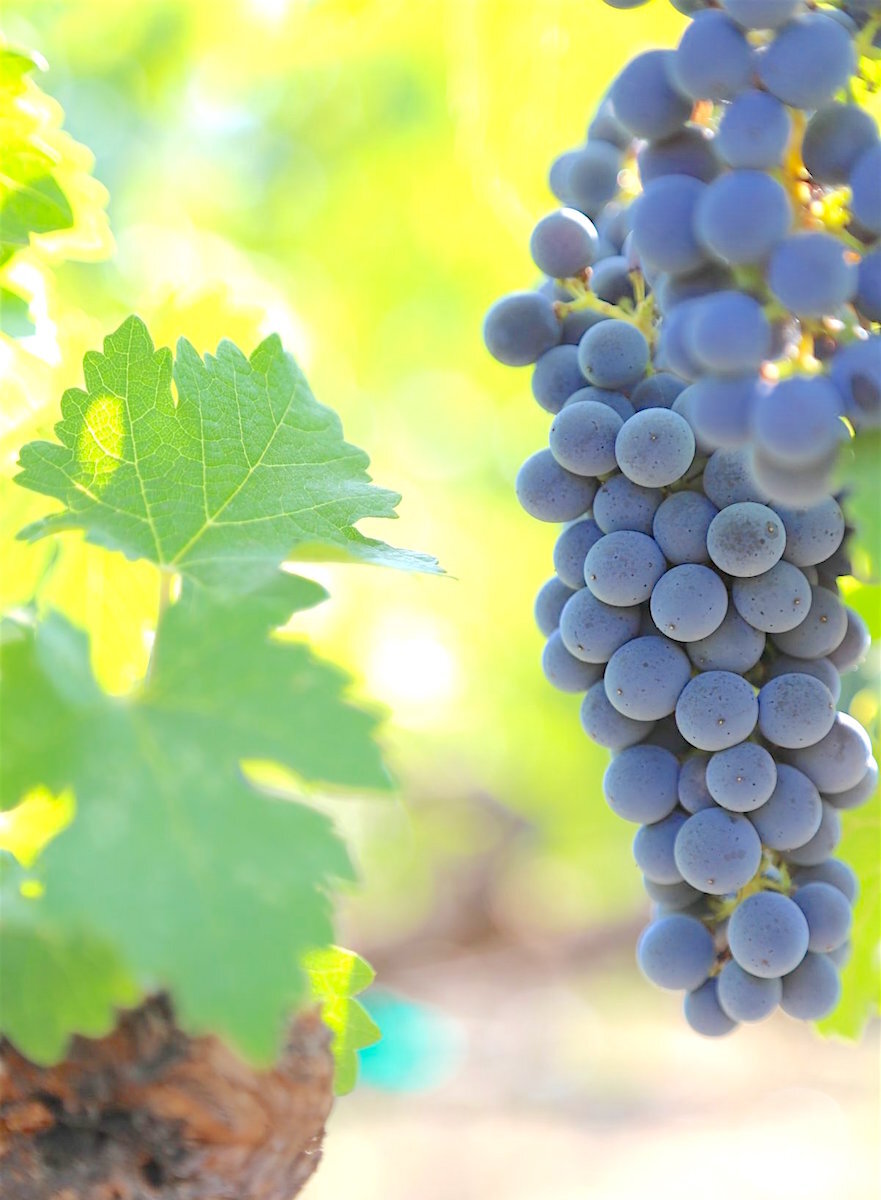
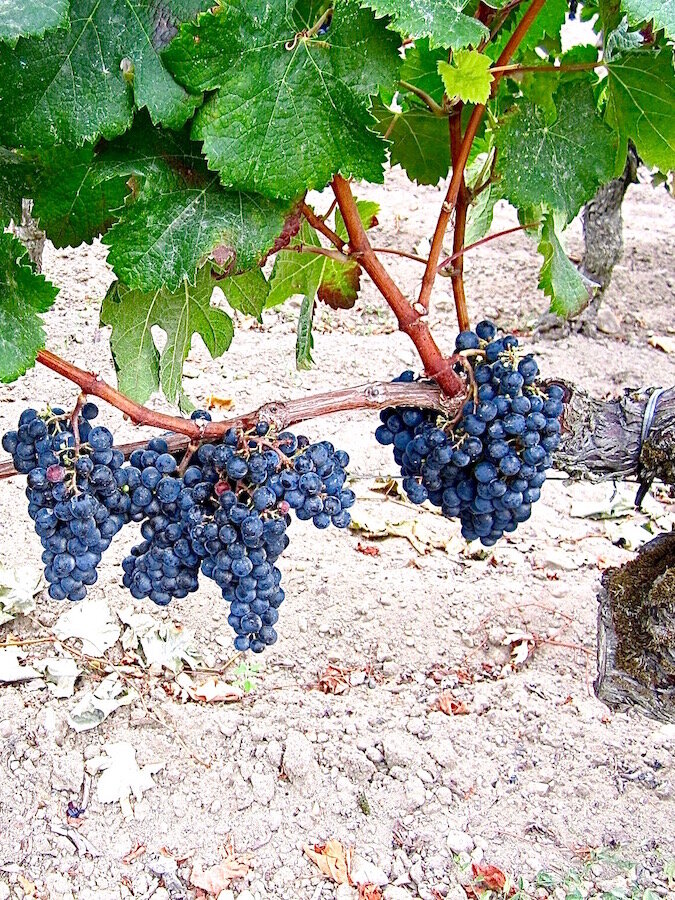
3.) CABERNET SAUVIGNON (Bordeaux, California, Italy): This legendary grape is the basis of many of the most expensive and age-worthy red wines on the planet - most notably in the Bordeaux region of France and California's Napa Valley. This is largely due to its reliably high levels of tannin which contribute greatly to a wine's overall structure and ageability. That being said, wines made from the Cabernet Sauvignon grape are available at many price points and the resulting wines display flavors ranging from tart red currants and graphite to rich blackberry, plum and cocoa depending on where it is grown. So for those of you who adore big red wines with intense tannins, Cabernet Sauvignon is the grape for you!
PAIR WITH: Cabernet Sauvignon is best matched with dishes that are equally as hefty as the wine itself - anything lighter would simply get blown away by its sheer power. Opt for dishes which are relatively high in fat and flavor such as a juicy, flavorful New York strip steaks, braised beef short ribs or savory grilled lamb chops.
GG FAVORITE CABERNET SAUVIGNONS:
Round Pond Kith & Kin Cabernet Sauvignon, Napa Valley, California ($38)
La Jota Howell Mountain Cabernet Sauvignon, Napa Valley, California ($99)
4.) SYRAH (Rhone, California, Washington): This intense red grape is the source of some of the most robust, deeply colored, full-bodied red wines on the planet. While is can be found as a varietal wine, Syrah is usually blended with other grapes (both red AND white!) to round out its spicy, exotic flavor profile. In cooler climates such as France's Rhone Valley, Syrah produces bold, complex wines with notes of black and red fruit accompanied by savory notes of herbs, bacon fat and olive tapenade. In warmer climates like Australia and South Africa where it is know as "Shiraz," Syrah produces lush, sometimes jammy wines with notes of cherry, blackberry and chocolate with a spicy, peppery finish.
PAIR WITH: Full-bodied Syrahs are perfect for pairing with luscious, flavorful dishes such as BBQ, burgers, braised beef dishes, juicy steaks and savory roasted leg of lamb.
GG FAVE SYRAHS:
5.) CABERNET FRANC (California, Bordeaux, Australia): Cabernet Franc, along with Sauvignon Blanc, is a parent of the Cabernet Sauvignon grape and while it might not be quite as popular, it is certainly worth exploring! While it can be found as a varietal wine in places like France's Loire Valley and California's North Coast, Cab Franc is usually a part of a blend, most notably in Southwest France where it is one of the five classic Bordeaux grape varieties. Here it is most popular on the famed Right Bank where it is usually blended with Merlot, most notably in Saint Emilion at the legendary Chateau Cheval Blanc. Cab Franc can display very different aromas and flavors depending on the climate in which it is grown. Cool climate Cab Franc displays notes of tart cherry, sweet herbs and mushroom accompanied by a delightful earthiness, while in warmer climates it reveals the grape's capacity for red berry fruit such as cranberry, pomegranate and strawberry along with notes of moss, forest floor and black tea.
PAIR WITH: This medium-bodied red pairs nicely with a wide variety of dishes such as Roast Chicken with Mushrooms, Provençal inspired Pork Chops, grilled Filet Mignon and hearty soups and stews.
GG FAVORITE CABERNET FRANCS:

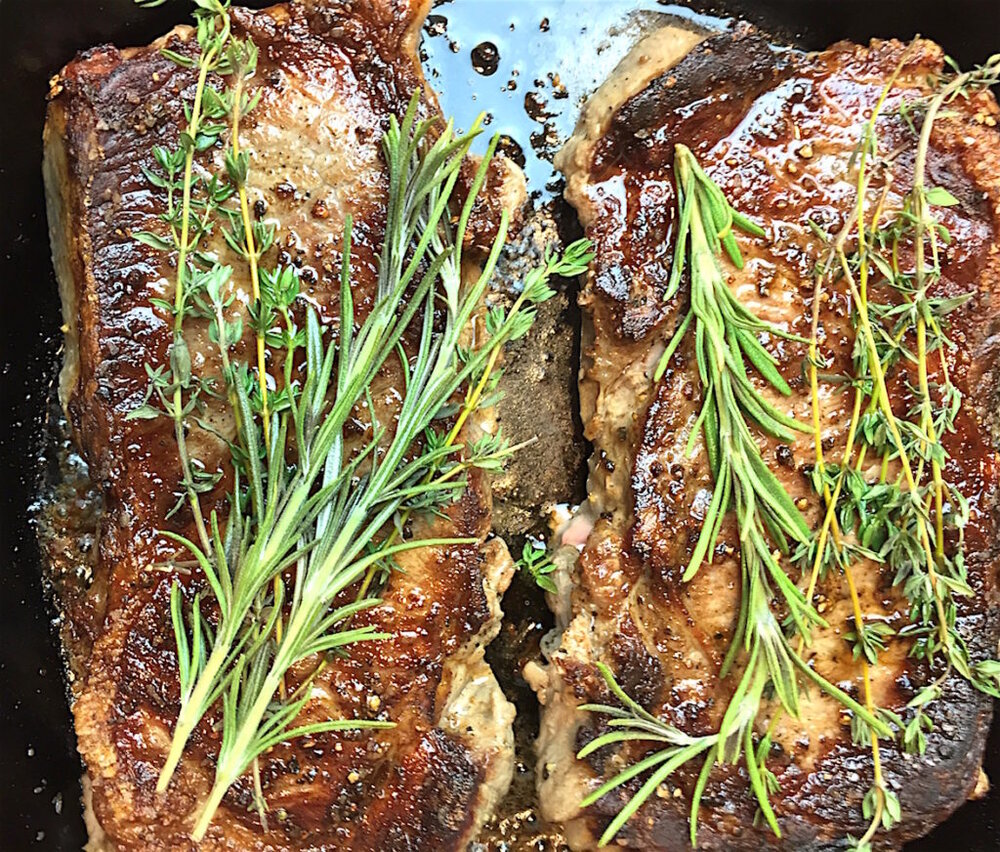
As with any type of wine, red wine has it’s own “lingo.” These terms refer to different winemaking tools or specific vinicultural techniques employed by winemakers when making this type of wine. No Red Wine 101 post would be complete without a list of those you’re most likely to encounter when talking about red wine:
TANNINS: These phenolic compounds set red wine apart from white wine and are imparted into red wine from its grape seeds, skins and stems as well as time spent in oak barrels. Tannins allow red wine to age with grace because they act as a preservative. They also add critical texture and mouthfeel to red wine, so when you feel the sensation of the moisture being sucked out of your mouth or a chalky feeling on your tongue after tasting a red wine, that’s the tannins!
SEDIMENT: As red wines age, their tannins tend to bind up with color molecules and precipitate out of solution and collect at the bottom of the bottle. Sediment is the layer of small, sand-like particles you encounter in these aged red wines. Generally, the more tannic the wine, the more sediment you’re likely to encounter. While sediment won’t hurt you if you drink it, the texture can be off-putting so it is often advisable to decant wine off of its sediment before drinking it, although in very old wines, always taste the wine first! While all young, tannic red wines can handle the sudden infusion of oxygen that occurs during decanting, old wines tend to be more fragile.
DECANT: Decanting is the process of transferring a wine from the bottle into a crystal decanter and there are two main reasons to do this: (1) decanting a youthful, tannic red wine infuses it with oxygen thereby softening its harsh tannins and making its aromas and flavors more readily perceptible. A super creative option popularized by Nathan Myhrvold in his books Modernist Cuisine utilizes a blender to "hyperdecant" young red wines - for my video demonstration of this process, please click here or click play on the video above, and (2) as red wines age, sediment often forms at the bottom of the bottle. These older red wines often need to be decanted off of their sediment for maximum enjoyment. While decanting a youthful red wine should be done vigorously, decanting an older red wine is a more delicate process. You don't want to risk over oxygenating the wine or stirring up the sediment.
OAK: The majority of red wines receive some degree of oak treatment during which the wine actually spends time in an oak barrel. While there are quite a few different types of oak, the most popular are French and American. French oak is used with the majority of red grapes such as Pinot Noir, Cabernet Sauvignon, Merlot and Cabernet Franc. It imparts notes of baking spices (i.e. clove, nutmeg) and vanilla to a finished wine. American oak, on the other hand, has a special affinity for certain red grapes such as Tempranillo and Zinfandel and manifests in the finished wine as notes of dill pickle, coconut and sweet vanilla.
RESVERATROL: This natural phenolic compound found in red wine is believed to have heart-healthy properties which help prevent damage to blood vessels, reduce bad (LDL) cholesterol and prevent blood clots although it’s not entirely understood how this works. Resveratrol is also found naturally in peanuts and berries which aren’t nearly as much fun and you can now find it in skincare products such as the Caudalie line as well!
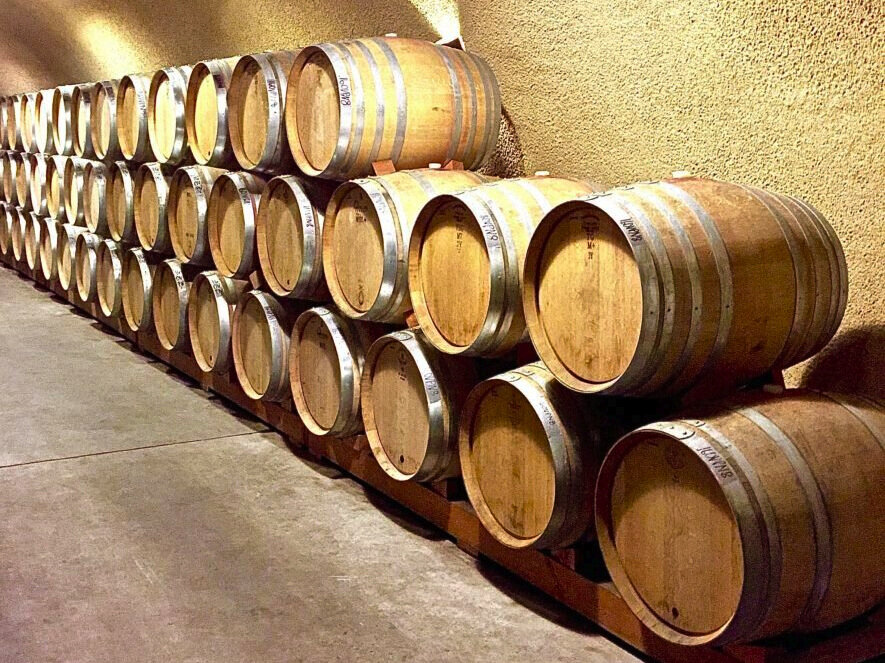
I hope you found my post on Red Wine 101 helpful in your understanding of this delightful, and imminently enjoyable wine. For even more on the topic, please check out my podcast episode, Red Wine 101, where I answer some interesting viewer questions and dish on some humorous personal experiences as well. If you missed my previous post, White Wine 101, please click here to get all caught up and check out some of my favorite Winter White Wine Recommendations as well!

If one of your #PandemicResolutions is to learn more about wine, I'm here to satisfy your vinous cravings with the perfect place to start: my Wine 101 blog series. Because, let's face it, wine can be a pretty confusing topic! It distills diverse subjects such as history, science, geography and anthropology into one delicious, liquid commodity. And while you don't have to worry about learning EVERYTHING, knowing the basics can certainly help you navigate this expansive topic.
As a long time student of wine, I gotta say, White Wine 101 is a fabulous place to start. Unfortunately, there's a nasty rumor out there that white wine shouldn't be taken as seriously as red wine and I couldn't be happier to kick that theory to the curb and tell you that’s flat out W R O N G! White wines represent some of the most expensive, elegant and age-worthy wines on the planet. Not to mention, they're also really delicious to drink.
But if you need a little more convincing, scroll down for a few important reasons why you should wholeheartedly embrace the world of white wine!
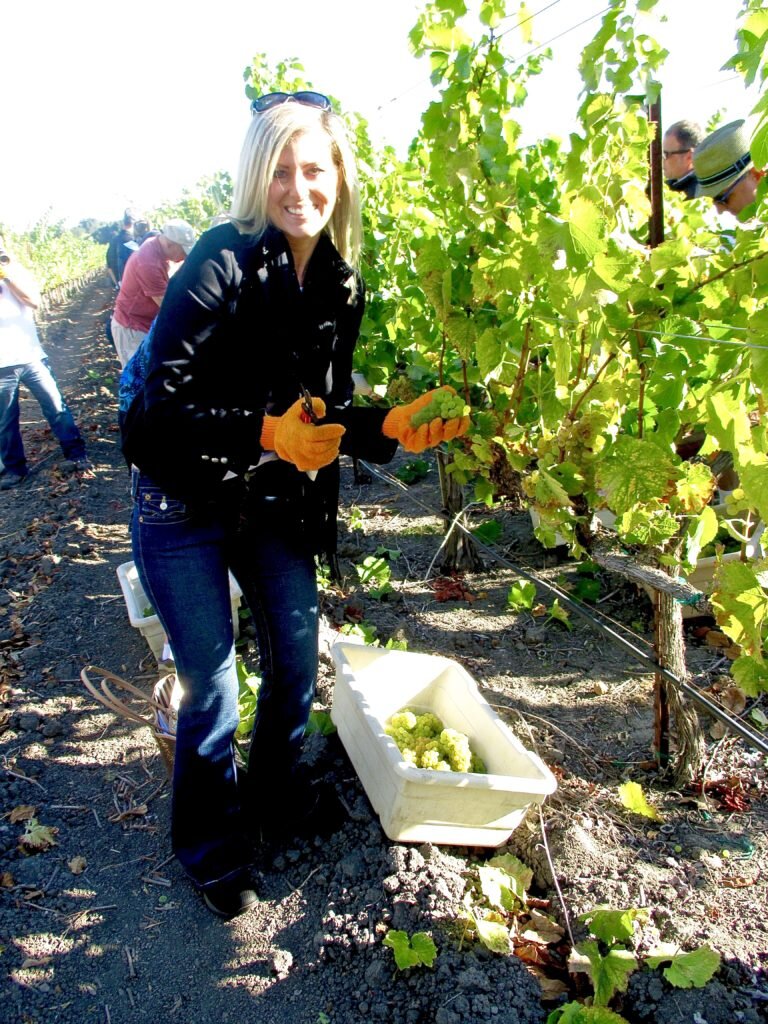

White wines are much more versatile when pairing with food, there's no harsh tannins to compete or clash with the flavors on your plate.
You're less likely to get a hangover when drinking white wine due to the lower levels of alcohol.
Most white wines are meant to be consumed while young, so no waiting for the wine to age or dealing with harsh tannins. Simply pop the cork (or twist the screwcap) and you're good to go!
Before we delve into the differences of white and red wine, let's talk about the one thing ALL wines have in common: fermentation! Every type of wine on the planet, whether it's sparkling, white, red, pink, blue or fortified, had to undergo fermentation. During the fermentation process, yeast converts grape sugars into ethanol (alcohol!) and carbon dioxide. Once the alcohol level gets high enough, the yeast cells die and voila - you have wine! When making still wines, the carbon dioxide is allowed to dissipate, but it sure comes in handy when making sparkling wine.
More on that later.
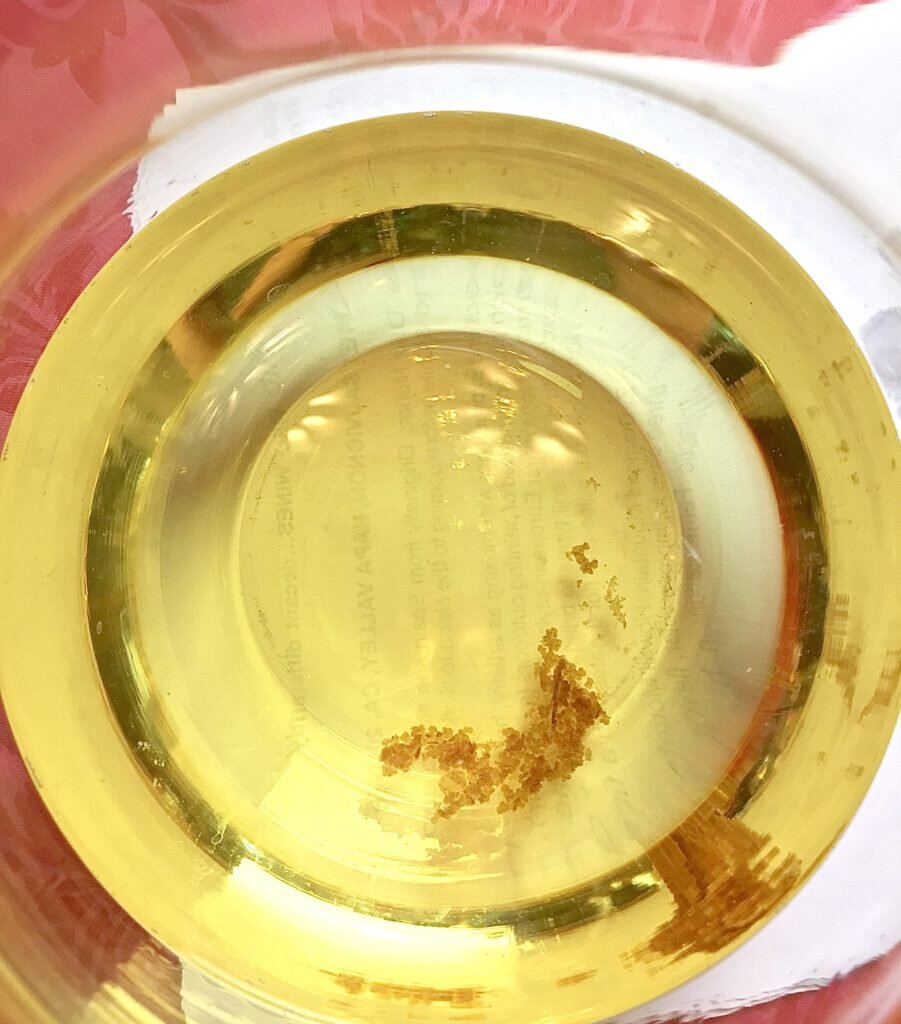
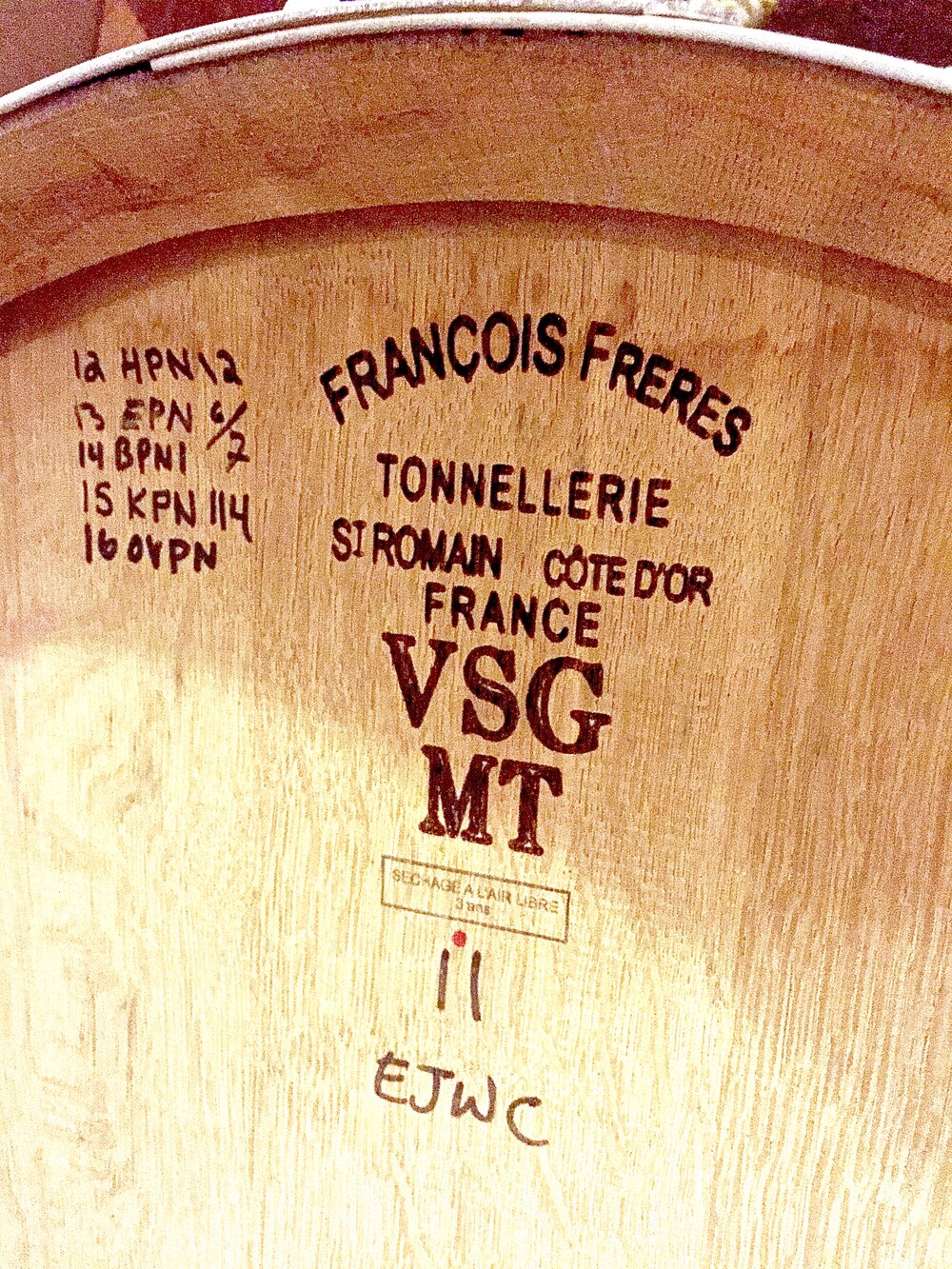
Now that we've talked about the one thing all wines have in common, let's talk differences. White wine production differs from the production of red wine in a few important ways:
SKIN CONTACT: White wines are fermented without their skins. Unlike red wines which get their color from contact with grape skins, white wines are gloriously translucent so the juice is pressed right off the skins to prevent any transfer of color or other errant phenolic compounds.
SULPHUR (aka SO2): The addition of sulfur plays a much bigger role in white wine production than red. In fact there are about twice the level of sulfites in white wine as there are in red! Yep, you heard me correctly, so if you're someone who suffers from the dreaded Red Wine Headache, I'm here to tell you - it definitely ain't the sulfites! (Click here for more info) The science behind it actually makes good sense, sulfur acts as a preservative for wine and prevents it from spoiling and turning brown. Red wines have built in preservatives in the form of tannins so they don't need the added protection from sulfur like white wines do.
COOL FERMENTATION: In order to preserve white wine's crisp, fruity flavors it it fermented at a much cooler temperature than red wine. 45-60 degrees is the sweet spot for white wine fermentation, while 70-85 degrees works best for reds.
COLD STABILIZATION: Tartaric acid is the primary acid we find in wine which is essential to its mouthfeel and taste. When wine is subjected to very cold temperatures, especially as it ages, the acid can precipitate out of solution and form harmless crystals, aka wine diamonds, at the bottom of the bottle. To prevent this from occurring, many winemakers cold stabilize their wines by subjecting them to cold temperatures for a period of time and then filtering the crystals out before the wine is bottled. Some winemakers feel this process can strip flavors from their wine so they do it sparingly which can result in crystals forming in their wine if it gets very cold.
As far as style goes, white wines can range from light-bodied and fruity to full-bodied and oaky. This largely depends on the grape variety, wine region and the way the wine is made.
When it comes to grapes, there are a few varieties you're most likely to encounter at your local retail store. Here is my White Wine 101 list of the top 5 grapes to look out for as well as what they taste like, what foods you should pair them with, and a few of my own personal favorites. Remember, if you can't find the exact wine listed here, be sure to ask your local wine shop to suggest a similar alternative:
1.) PINOT GRIGIO/PINOT GRIS (Italy, Oregon, Alsace): Pinot Grigio thrives in Northeastern Italy, specifically Friuli and Alto Adige, where it produces light-bodied, refreshingly fruity wines that are imminently quaffable, if a tad forgettable when mass produced. Pinot Gris, the same grape grown in different geographic regions including Alsace and the Northwest US, is know for having more flavor, viscosity and overall personality.
PAIR WITH: While this wine is perfect served as an aperitif, it also pairs nicely with lighter fare such as grilled fish (Pinot Gris in particular is perfect with salmon), lighter pasta dishes and roasted chicken breast.
GG FAVE PINOT GRIGIO/GRIS:

2.) RIESLING (Germany, Alsace, Washington, New York State): This grape produces fruity, aromatic wines with a lively acidity and delightful fruit profile which displays citrus, green apple, pear and jasmine tinged usually to some degree with it's hallmark petrol note. Riesling can also run the gamut stylistically, ranging from bone dry to super sweet.
PAIR WITH: Sweet Riesling is a natural match for spicy Asian food such as Thai dishes and sushi. Dry Riesling is a wonderful pairing for vegetable-driven dishes, Tex-Mex cuisine and lighter seafood fare.
GG FAVE RIESLINGS:
3.) SAUVIGNON BLANC (New Zealand, California, Loire Valley): This charismatic white grape creates wines which are famously crisp and refreshing with a zesty acidity and lively fruit flavors ranging from grassy and grapefruity in New Zealand to peachy and citrusy in California. France's Loire Valley imparts limestone and mineral components to these wines as well as the infamous yet desirable, "pipi de chat."
PAIR WITH: Sauvignon Blanc is a fabulous food wine that pairs brilliantly with cheeses such as tangy chevre and shellfish like oysters, clams and shrimp. It can also play nicely with lighter fare such as pasta with white sauce, chicken and even pork, it's truly a food lover's white wine.
GG FAVE SAUVIGNON BLANCS:
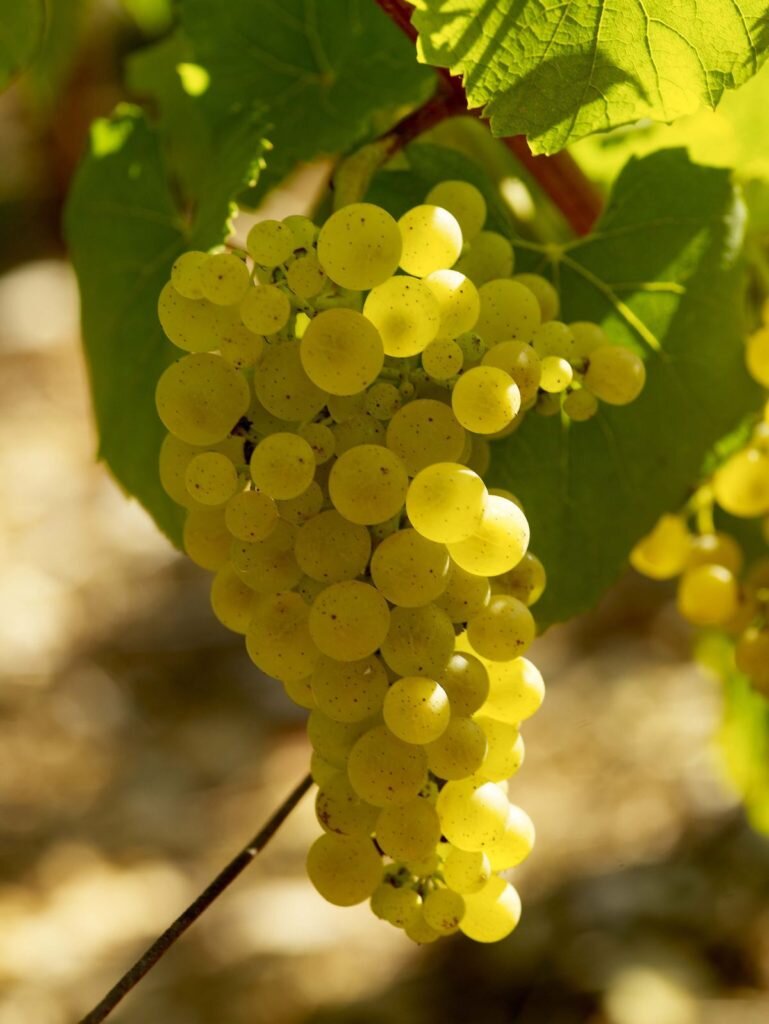
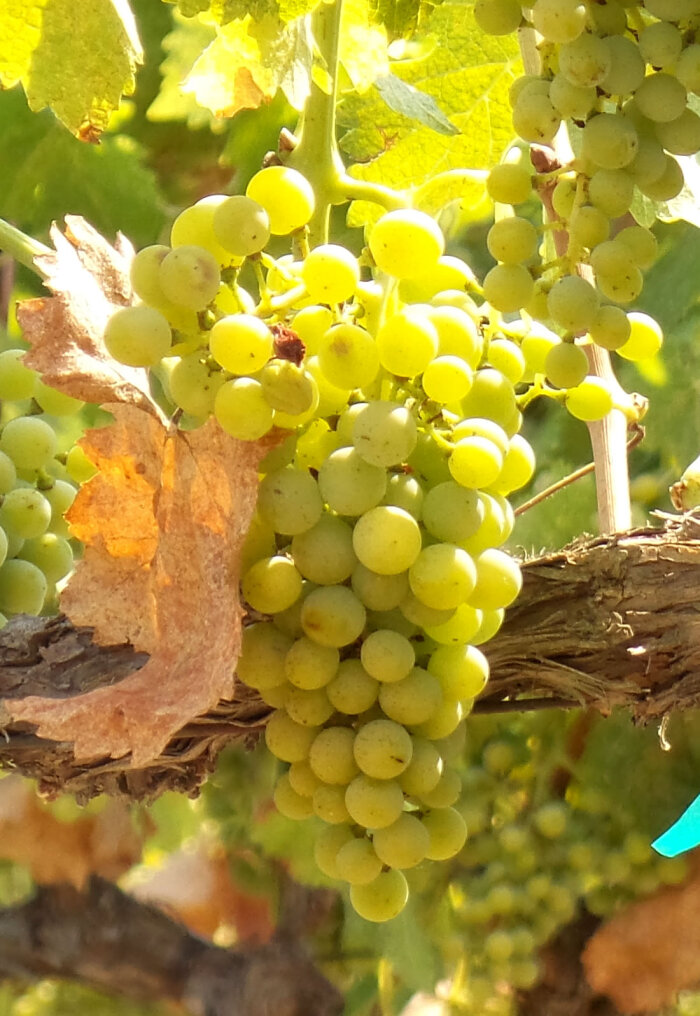
4.) CHARDONNAY (US, Chile, Burgundy, Champagne): The most popular and widely planted white wine grape produces some of the most beautiful, expensive and age worthy white wines in the world. Chardonnay is also know for expressing its "terroir,"meaning it reflects the specific region it was grown in. As a result its can display a variety of flavors and textures ranging from flinty notes of green apple, melon, citrus and limestone in cooler climates and ripe, full-bodied peach, pineapple and mango tinged with vanilla and spice in warmer climates.
PAIR WITH: Unoaked incarnations of Chardonnay are perfect for pairing with lighter dishes such as seafood, salads and chicken dishes. Oaked Chardonnay can be a bit tricky to pair with food, but generally pairs nicely with more decadent dishes including Roasted Chicken and Mushrooms and Lobster Mac and Cheese.
GG FAVE CHARDONNAYS:
Maison Joseph Drouhin Vaudon Chablis, Burgundy, France ($22)
Hartford Court Russian River Valley Chardonnay, Sonoma, California ($26)
5.) VIOGNIER (Rhone Valley, California, Australia): The Viognier grape produces full-bodied white wines that are utterly delicious! In cool climates like the Rhone, aromas and flavors of citrus and stone fruit are accompanied by gorgeous notes of white flowers and minerals. In warmer climates, like California and Australia, lush notes of tropical fruit like pineapple, mango and apricot are brought to the fore.
PAIR WITH: Decadent cheeses such as a triple creme Brie or Saint Angel, rich seafood dishes such as succulent seared scallops and roast chicken with apricots.
GG FAVE VIOGNIERS:
Chateau de Saint Cosme Condrieu, Rhone, France ($55)
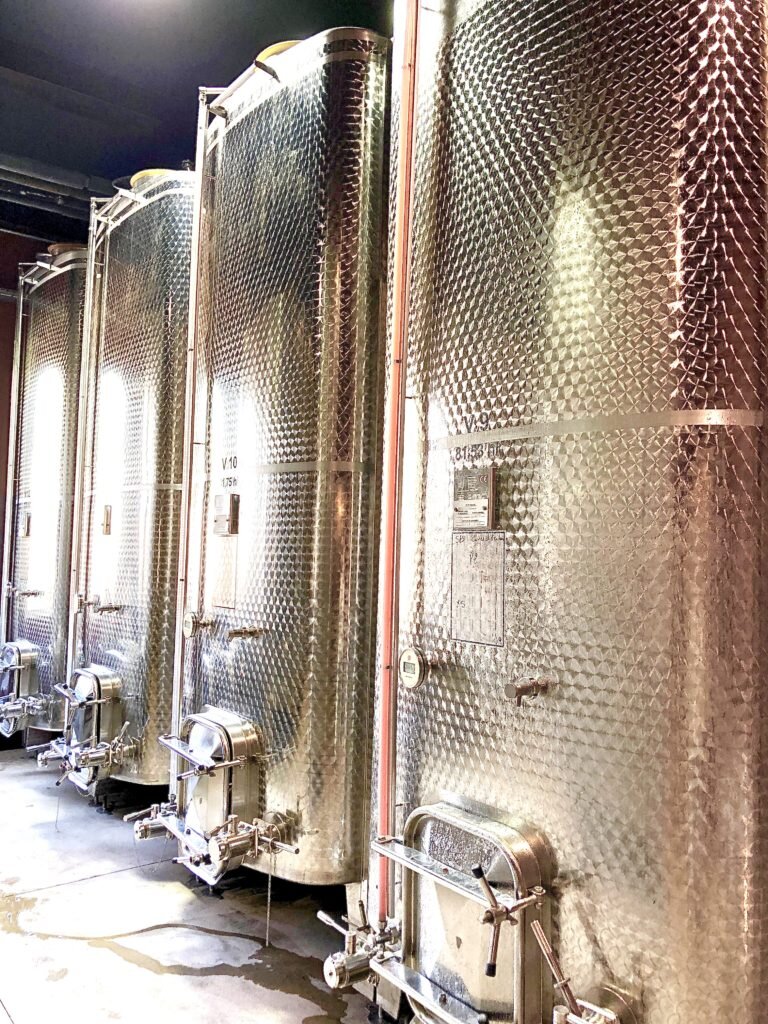
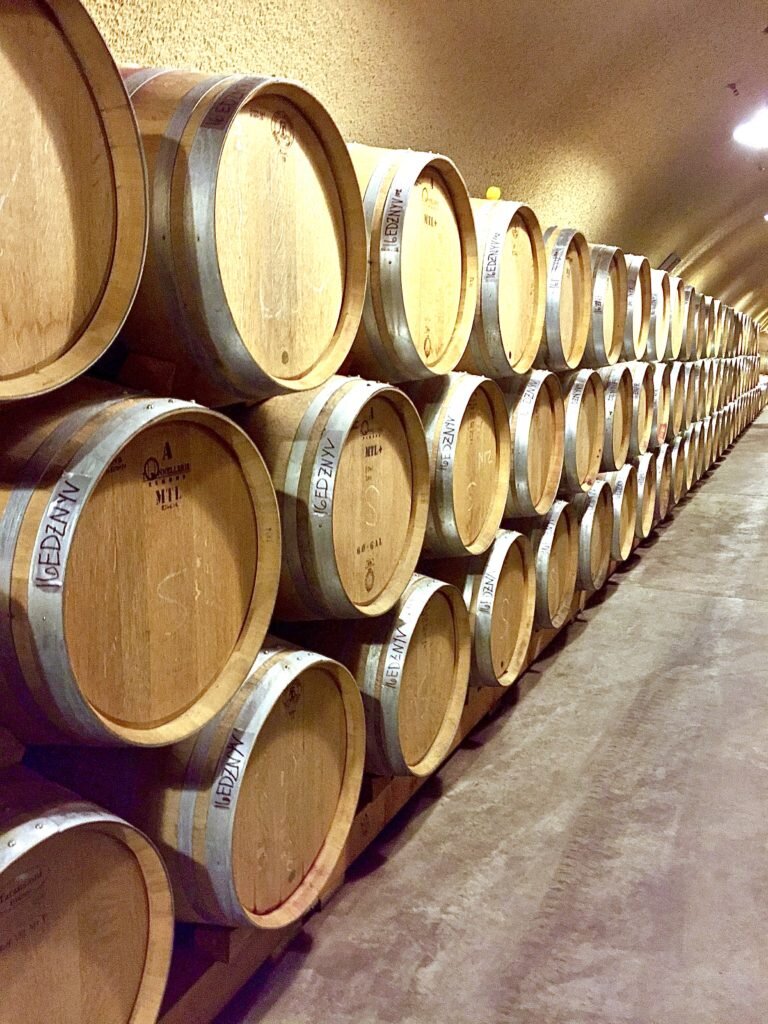
As with any type of wine, white wine has it's own "lingo." These terms can refer to different winemaking tools or specific techniques employed by winemakers. No White Wine 101 post would be complete without a list of those you're most likely to encounter when talking about white wine:
STAINLESS STEEL: Wines fermented in stainless steel tanks are crisp, fruity and refreshing. These wines are generally ideal for warmer Summer months and are usually wines meant to be consumed immediately, meaning they will not improve with age.
OAK: Some white wines, predominantly Chardonnay, are fermented in oak barrels. Oak (usually French) imparts added richness and flavor to the finished wine and also gives it a greater ability to age. In addition to fruit, oaked wines will also display notes of vanilla and baking spices (i.e. nutmeg, clove) which are transfered into the wine during it's contact with the toasted barrels.
MALOLACTIC FERMENTATION: White wines undergo this secondary fermentation when a winemaker wants to soften harsh malic acid, into creamy lactic acid. "Malo" occurs shortly after or concurrent with primary alcoholic fermentation when lactic bacteria are added which ultimately transform tart, green apple flavors into those of a buttery, baked apple. It is predominantly used with Chardonnay, resulting in a wine with a buttery, rounder, fuller mouthfeel.
SUR LIE/BATTONAGE: "Sur lie" or "on the lees" is when a wine remains in contact with the dead yeast cells after fermentation. These dead cells impart a richer mouthfeel, texture and flavor to the wine. Battonage refers to the stirring up of the yeast cells to maximize their contact with the wine.
I hope you found this post on White Wine 101 helpful to your understanding of this delightful, and sometimes underestimated, type of wine. For even more on the topic, check out my podcast episode, White Wine 101, where I answer some interesting viewer questions and dish on some humorous personal experiences as well. When you’ve sufficiently soaked up all of this information, please proceed to the next installment, Red Wine 101!
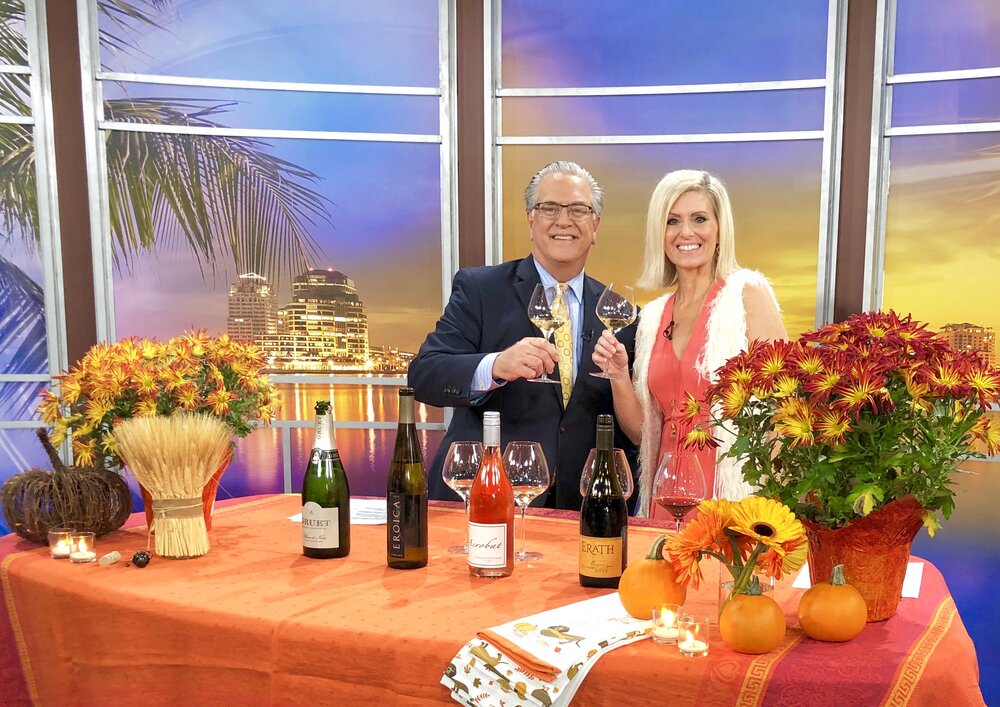
Looking for the perfect Thanksgiving wines that'll pair with everything on your table, make even your wine snobbiest guest happy and won't break the bank?
Well, look no further! In my latest segment on WPTV I share some fabulous wines that all play nicely with a wide variety of flavors, appeal to a plethora of palates and are all under $20 a bottle! The fabulous John Favole also asks an important wine related etiquette question that you won't want to miss if you're hosting a holiday meal or plan on being a guest at someone else's home.
Also, just in case you're in need of some great Thanksgiving recipe recommendations like the perfect turkey or dessert, a list of Thanksgiving Kitchen Equipment Essentials or an indispensable Thanksgiving Day Cheat Sheet feel free to click on the respective links.
I hope you find my recommendations helpful and please see below for a list of wines featured in this episode. To view the full video, simply click the link below. Wishing you and your family a wonderful and delicious Thanksgiving!

1.) Gruet Blanc de Noirs Brut, New Mexico, NV ($18): Pale salmon in color, this Blanc de Noirs has aromas of berry + pear, complimented by a rich, round mouth feel on the palate. It finishes with a layer of cream + pleasant, warm toastiness + is incredibly versatile with all styles of food!
2.) Chateau Ste. Michelle Eroica Riesling, Columbia Valley, Washington ($19): Exhibits sweet lime + mandarin orange aromas with subtle mineral notes. A delightful mouth-watering acidity is beautifully balanced by bright, flavorful citrus + stone fruit accompanied by a crisp acidity and lovely minerality.
3.) Acrobat Pinot Noir Rosé, Willamette Valley, Oregon ($15): This delightful rosé tempts with aromas of watermelon, lychee, kiwi + a hint of spice. Flavors of raspberry, plum + pomegranate are enhanced by a wonderful viscosity + hint of sweetness which melts away on the lengthy dry finish.
4.) Erath Pinot Noir, Willamette Valley, Oregon, ($14): Classic Oregon aromas of black cherry, plum + currant mingle with hints of anise + sandalwood. Flavors reflect the aromatics with more cherry + plum with a touch of graham cracker. Hearty + robust, yet smooth + approachable this gem is guaranteed to delight!
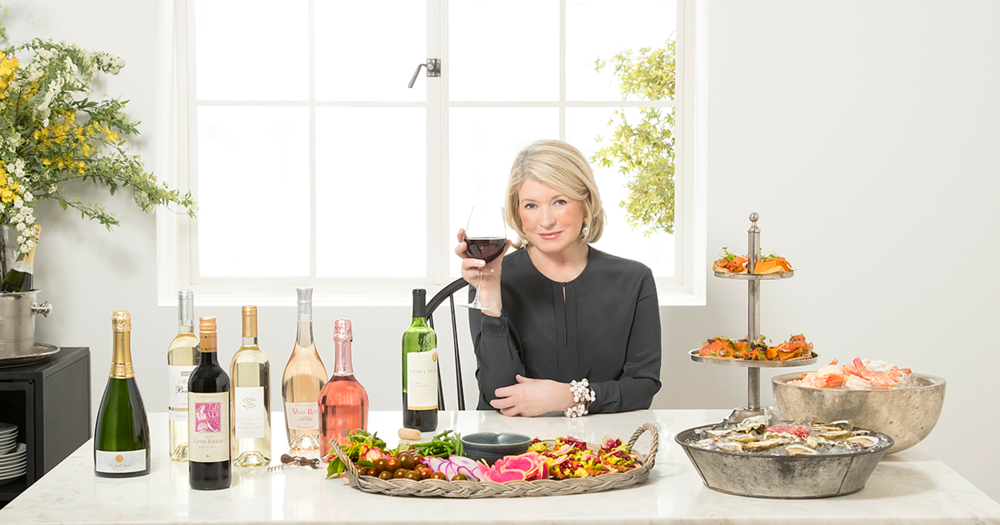
Offers for wine clubs are E V E R Y W H E R E these days!
From department stores to airlines, it seems like everyone wants to sign you up and they're making pretty outrageous-sounding offers to lure you in. One promises "20 wines for a dollar," while another features ONLY "award winning wines" - they all sound great...but ARE they?
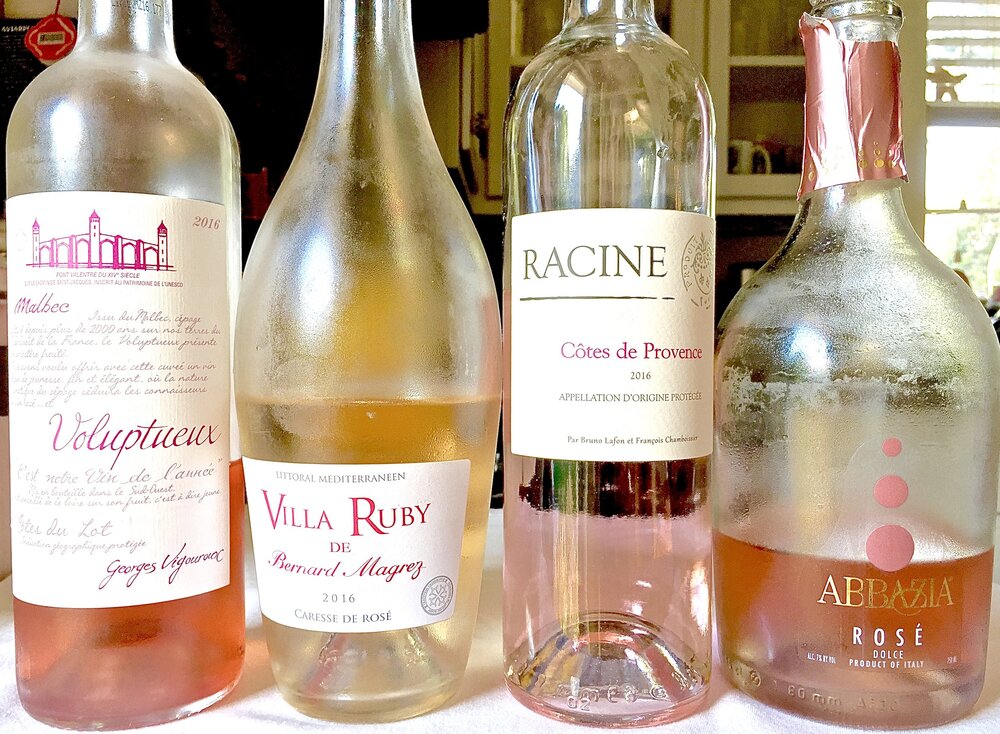
In this week's episode of Wines of the Week on Facebook LIVE I tackle this timely topic and feature important Wine Club Warning Signs to keep in mind while shopping around. I'm also happy to taste my way through our featured wines which all come from the Martha Stewart Wine Co.
Yes, Martha has gotten in the wine game, but is her wine club a #goodthing?
Please watch the video below for all the details!
1.) Georges Vigouroux Voluptueux IGP Côtes du Lot Rosé, France, 2016 ($12)
2.) Villa Ruby de Bernard Magrez 'Caresse de Rosé,' IGP, France, 2016 ($15)
3.) Racine Cotes de Provence Rosé, Provence, France, 2016 ($15)
4.) Abbazia di San Guadenzio Moscato Rosé Dolce, Piedmont, Italy, NV
- Martha Stewart Wine Co. website
- All the deets on the different methods of making sparkling wine
- 4 Wine Club Warning Signs to keep in mind when shopping (scroll to 35:55 in the video for the full list)
I hope you enjoy this episode of “Wines of the Week” featuring Wine Clubs 101 and selections from Martha Stewart's Wine Club. Please watch the video above for ALL the details including my tasting notes on our featured wines as well as my checklist of Wine Club Warning Signs. I’d also love to hear about YOUR experience with wines clubs, good OR bad so please leave your comments below. And to view previous episodes of “Wines of the Week,” please click here!

Nowhere embodies relaxed Summer glamour quite like the Hamptons. Located on the East End of Long Island, this sophisticated seaside haven is also home to our favorite Summer event, the James Beard Foundation's "Chefs & Champagne." Held on the last Saturday in July, this glamorous Summer soirée takes place under a sprawling white tent beneath cerulean skies, at the scenic Wölffer Estate in the village of Sagaponack.
It combines delicious, seasonally-inspired offerings from over 35 Chefs accompanied by flowing Champagne as well as an array of Wölffer Estate's eponymous wines. It is truly a feast for the senses and this year also featured some very special new faces.
The 2018 "Chefs & Champagne" event marked the first for the foundation's newly appointed CEO, Clare Reichenbach. The charismatic, blonde Brit (pictured below) brings her seasoned experience as executive vice president of strategy for BBC Worldwide and AMC Networks, to the renowned culinary organization, as well as extensive media expertise gained by working with clients including NBC Universal and New York Public Radio.
A self-described "deeply impassioned home cook," Reichenbach rallied the crowd of revelers by announcing the evening's enduring themes of, "good food, for good" and "pleasure with a real purpose." She also added, "we celebrate excellence in food, and we delight in deliciousness." I couldn't agree more!
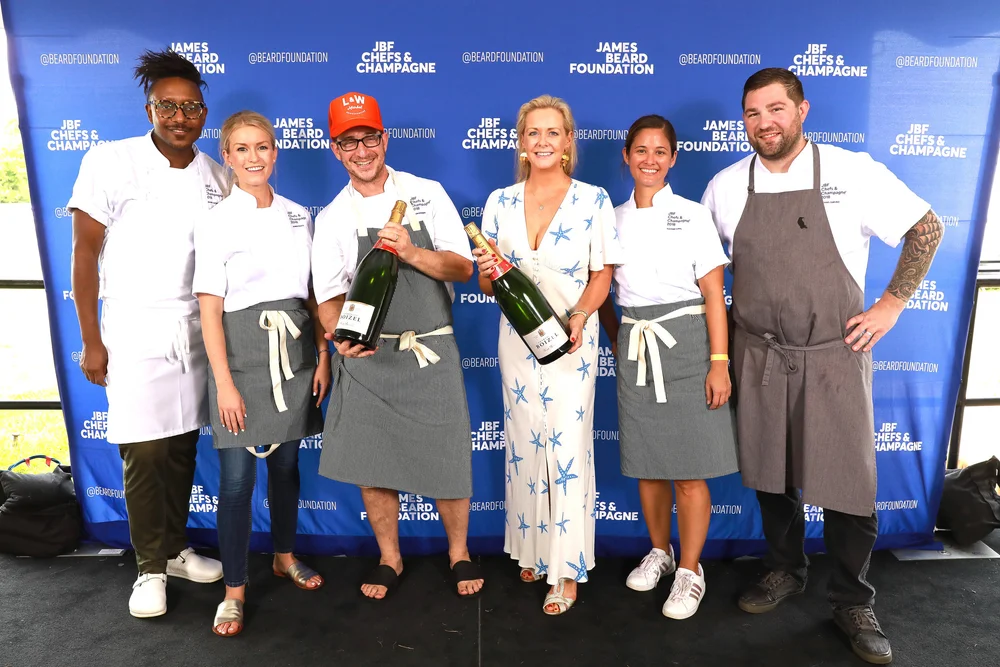
But perhaps the overarching theme of the evening was the most timely, namely, the equality of women in the culinary arena. Spawned by the #MeToo movement and numerous sexual misconduct allegations in the culinary realm, Reichenbach also cited some sobering statistics, "While half of culinary students are women, they make up less than 20% of Chefs and head cooks."
The evening's ethos of equality was a continuation of May's James Beard FoundationAwards, which challenged the food community to RISE for diversity, culture and inclusion to ensure a seat at the table for everyone.
Which brings me to this year's Honoree. In her announcement, Reichenbach began, "Her passion for food, family and feminism makes her the ideal honoree for this year's event," and she couldn't have been more right! Padma Lakshmi is truly a driving female force in the culinary world. In addition to her titles of food expert, model, actress and best-selling author, she's also the host and executive producer of Bravo's James Beard award winning and Emmy award winning show Top Chef.

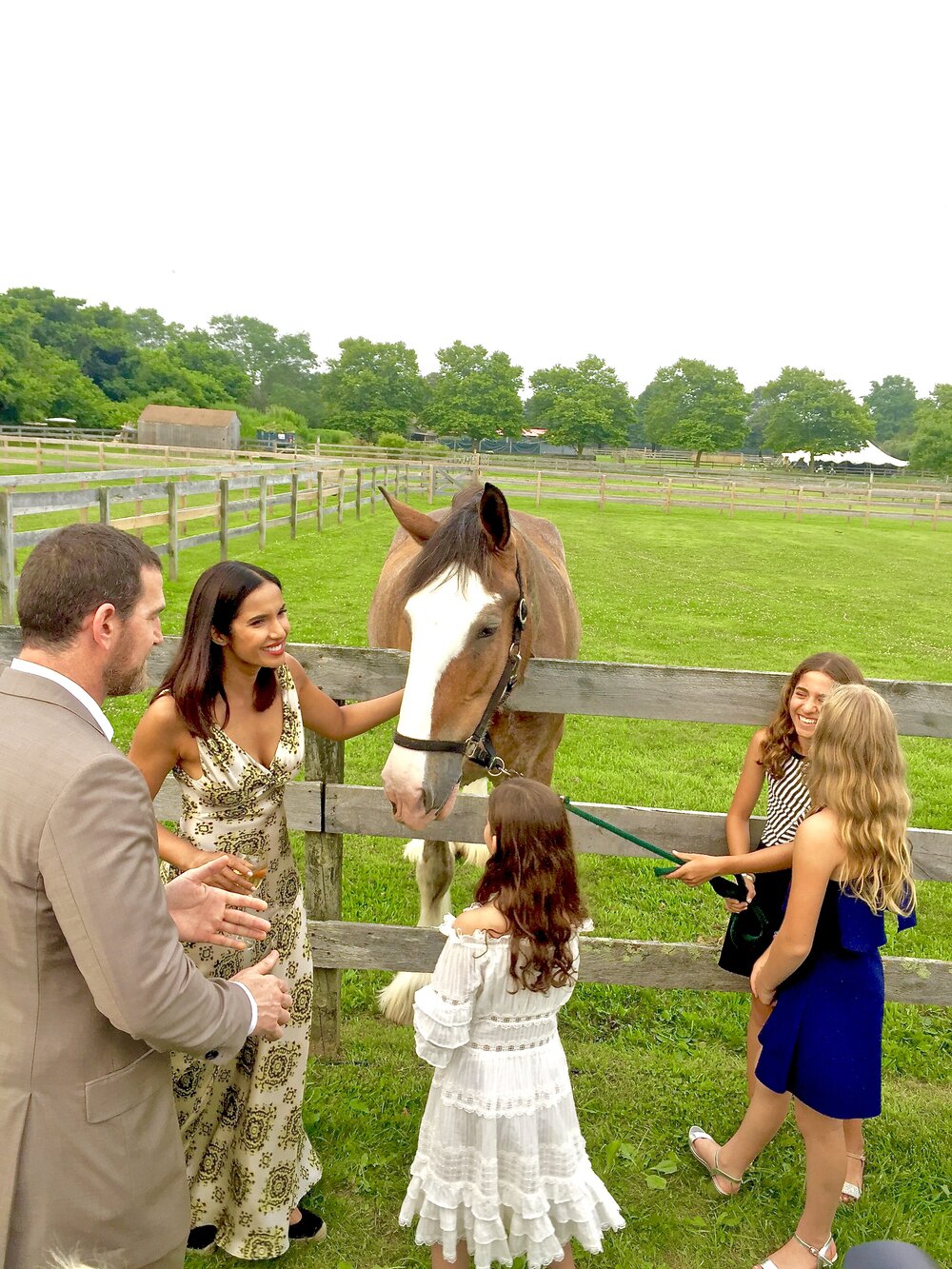
I was fortunate to have the opportunity to speak with the luminous Lakshmi about her favorite Summer flavors, passions outside of food and what it means to be honored by the James Beard Foundation before the event got underway:
Q: How have you been enjoying the Hamptons so far?
A: "I just got here today, I've been filming the finale of Top Chef overseas in China. If feels good to be back but I'm a little jet-lagged."
Q: You contributed so much to the food world in such a unique way, what does it mean to be here and be honored by the James Beard Foundation today?
A: "It feels great, it feels so exciting! I've always admired Chefs who were of James Beard caliber, and also cookbooks that were recognized by the James Beard Foundation so to be here as their Honoree is really fantastic and a life bucket list dream come true."
Q: Since we're almost halfway through, what are your favorite flavors of Summer?
A: "It's a little early, but in a few week the corn will start to come in really sweet and ripe. The tomatoes are divine and we have a ton of basil in our garden so instead of always making pesto, we make green curry with it. My most favorite flavors of Summer though are peaches and tomatoes."
Q: As a Sommelier, I have to ask, do you have any favorite wines or cocktails you specifically enjoy in the Summer?
A: I mean, I love really good wine, I love [Chateau] Figeac, I also love Tignanello.
Q: You've inspired so many people to experiment in their own kitchens and think outside the box, are there any spices in particular you think of when it comes to Summer that people should explore?
A: "Here's two Middle Eastern spices, one is Sumac and one is Za'atar powder and I mention those two together because in the Summer you have such beautiful vegetables and it's easy to make a very simple yogurt dip with just yogurt, those two spices and salt and maybe a pinch of cayenne if you like things spicy. It's a great healthy snack for kids and adults and you put it out and it's beautiful. We actually make a ton of it and use it on our baked potatoes as well, instead of sour cream."
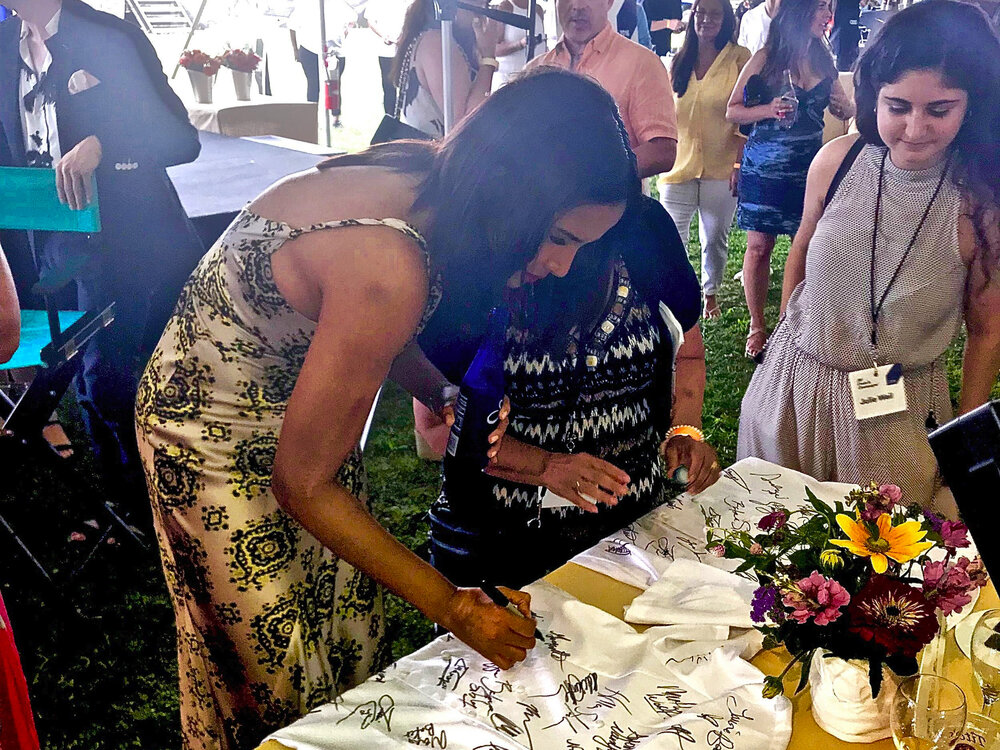
Q: You've filmed Top Chef in so many amazing places, if you could pick anywhere to film it next, where would it be?
A: I'd really love to do a finale in Goa. I'd love to be able to bring Top Chef to my home country. I just think Goa would be such a beautiful place, not only because of the Portuguese influence but also the wonderful mix of food and also the natural beauty. You have the beaches, the nightlife and the historical side - it's got a little bit of everything.
Q: What's been your favorite place to film Top Chef so far?
A: Singapore was pretty good, Hawaii was beautiful and I loved filming in New Orleans as well.
Q: What are your greatest passions in life outside of food?
A: My daughter of course, rollerskating, and reading. I love all those things.
Q: What are you reading right now?
A: Actually I'm reading this book by Francine Prose and it's called "What to Read and Why." And it's just a beautiful book of essays and it really reignites your love of classic books. And it's written in such an approachable, down to earth way, it makes you all of a sudden want to go back and read Tolstoy. She's such a great writer.
Q: Do you have a favorite culinary quote or words to live by?
A: Yes, "'Tis an ill cook who cannot lick his own fingers!" It's from Shakespeare's Romeo and Juliet."


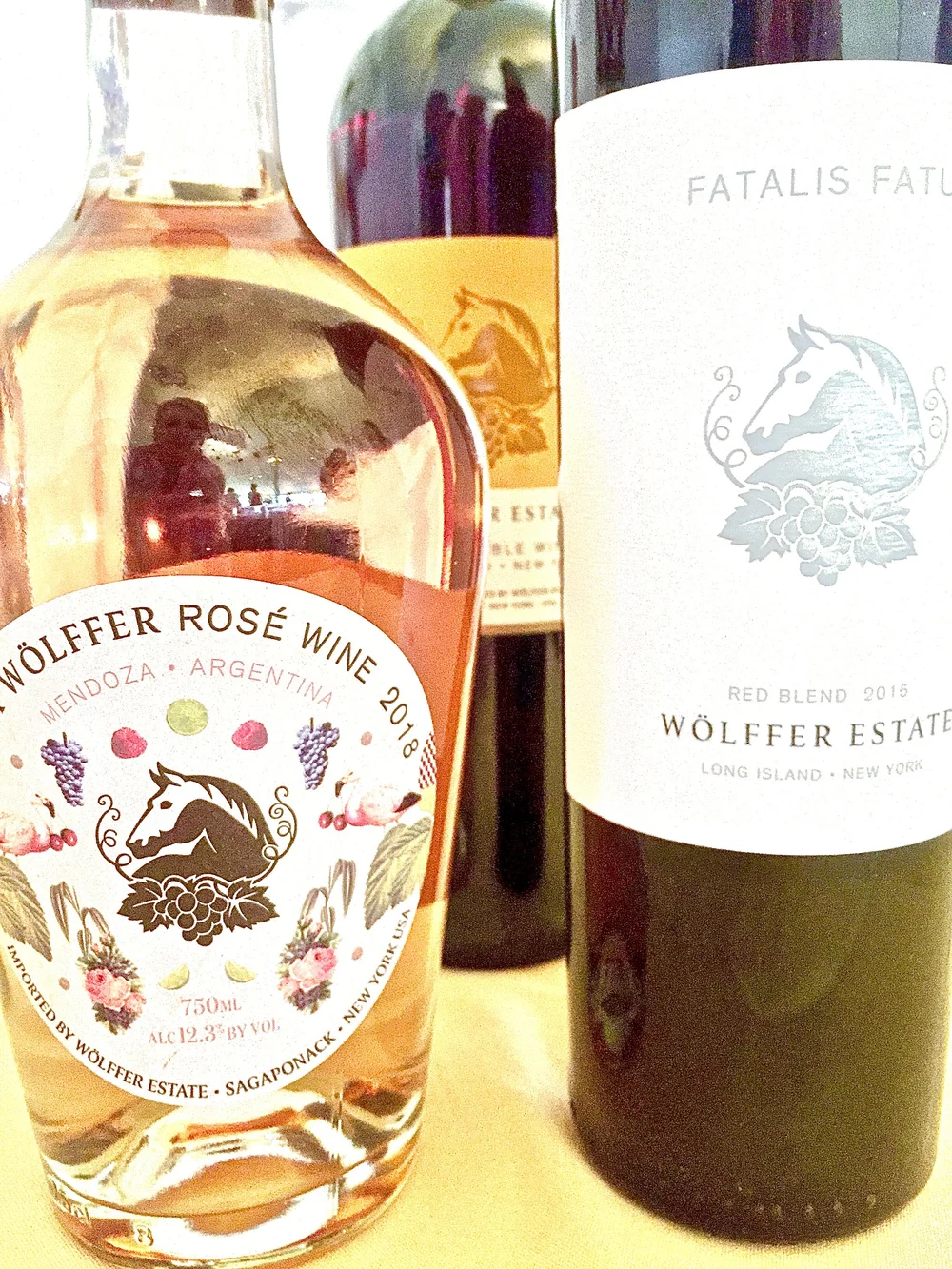
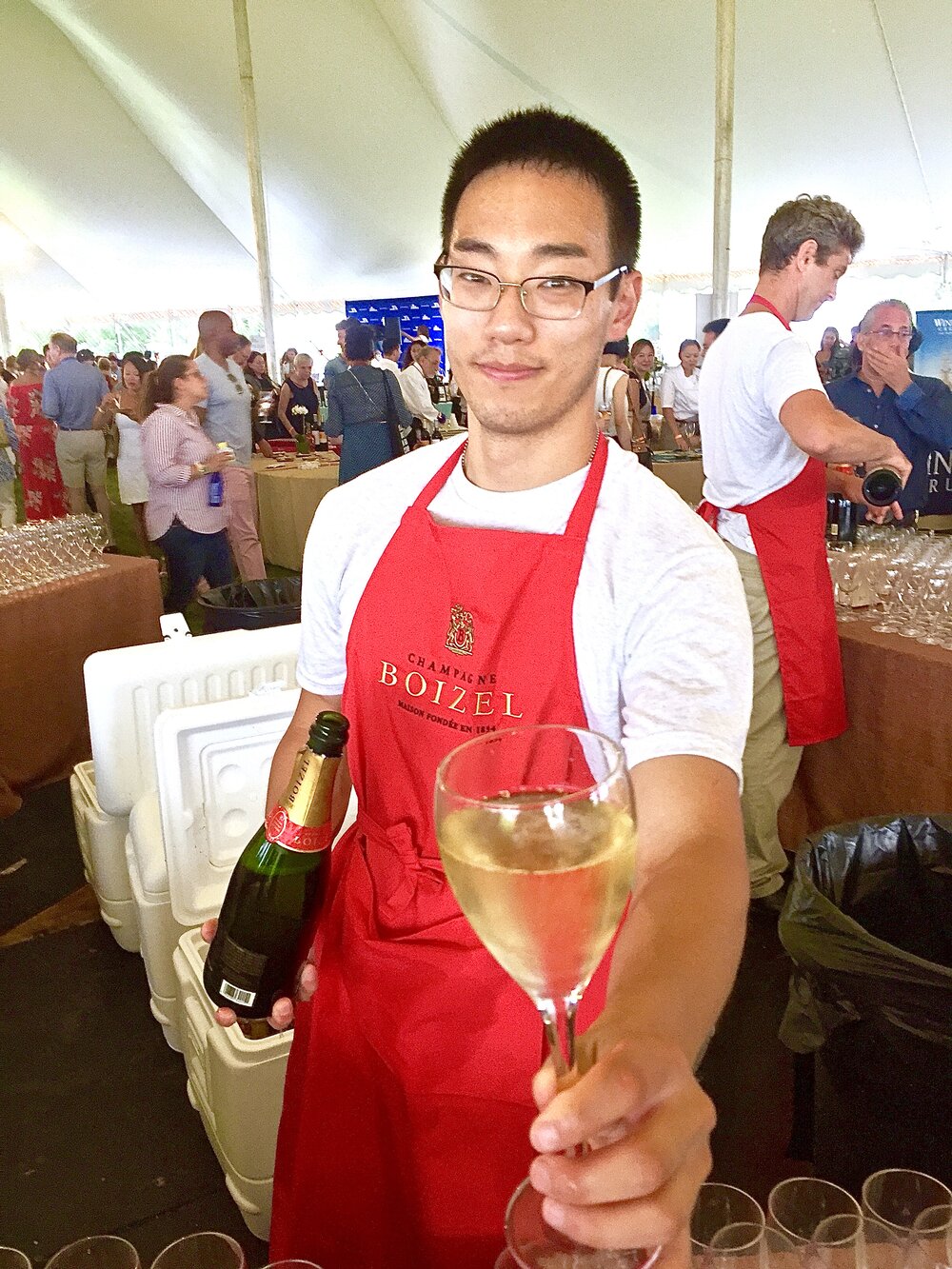
Once again, the food at the 2018 Chefs & Champagne event was truly spectacular! As in years past, I have to share my Top 10 Tantalizing Dishes with you - please scroll down for the deliciousness:
1.) Calvisius Tradition Prestige Caviar (White Sturgeon): The silky, slightly saline taste and delicate yet firm texture of this Italian caviar was positively dreamy and the perfect pairing for the Boizel Champagne.
2.) Red Velvet Macaron with Foie Gras Mousse + Aged Balsamic by Chef Adrienne Cheatham of SundayBest Pop-Up Series: The combination of the moderately sweet macaron and silky foie mousse were positively heavenly. The balsamic drizzle and flourish of briny sea salt made the perfect finish!
3.) Tarte Pissaladière (Savory Onion Tart with Anchovies, Niçoise Olives + Arugula) by Chef Georgette Farkas of Rotisserie Georgette in NYC: This classic dish from the South of France was a real treat and the bright arugula provided a fresh pop for the savory, salty olives and anchovies.
4.) Whipped Feta with Watermelon + Pistachio Dukkah by Chef Ayesha Nurdjaja of Shuka Restaurant in NYC: The airy texture of the feta was the perfect counterpoint to the dense chunks of sweet, ripe watermelon. The generous sprinkle of chopped pistachios, seeds and spices added delightful depth and earthiness to the dish as well.
5.) Olive Oil-Poached Chinook Salmon with Charred Leek Emulsion, Jersey Corn Puree, Black Garlic + Corn Cracklings from Chef Matthew Woolf of The Rainbow Room: We were absolutely smitten with the silky texture of the salmon as well as the combination of flavors and textures of the accoutrements!
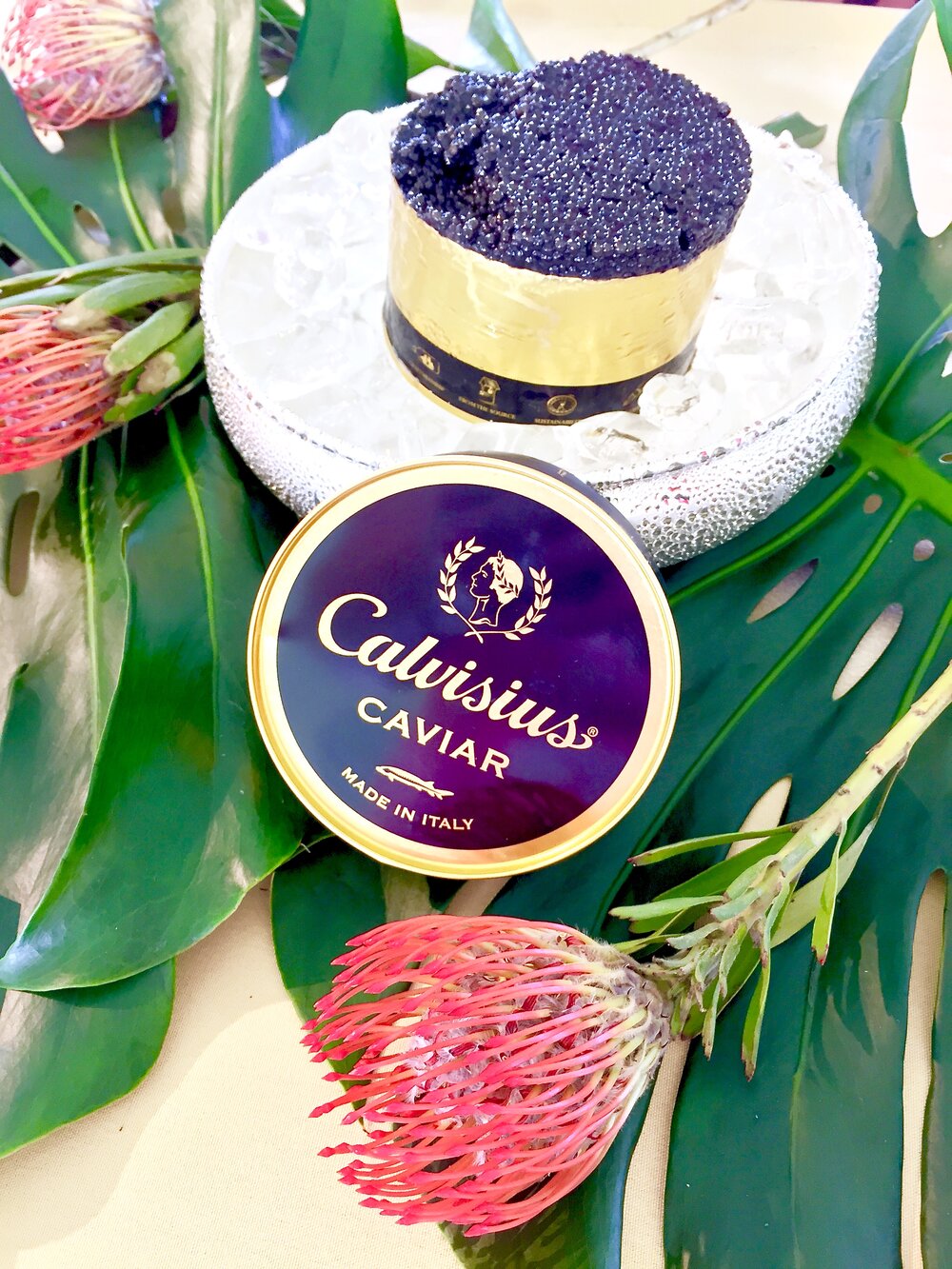
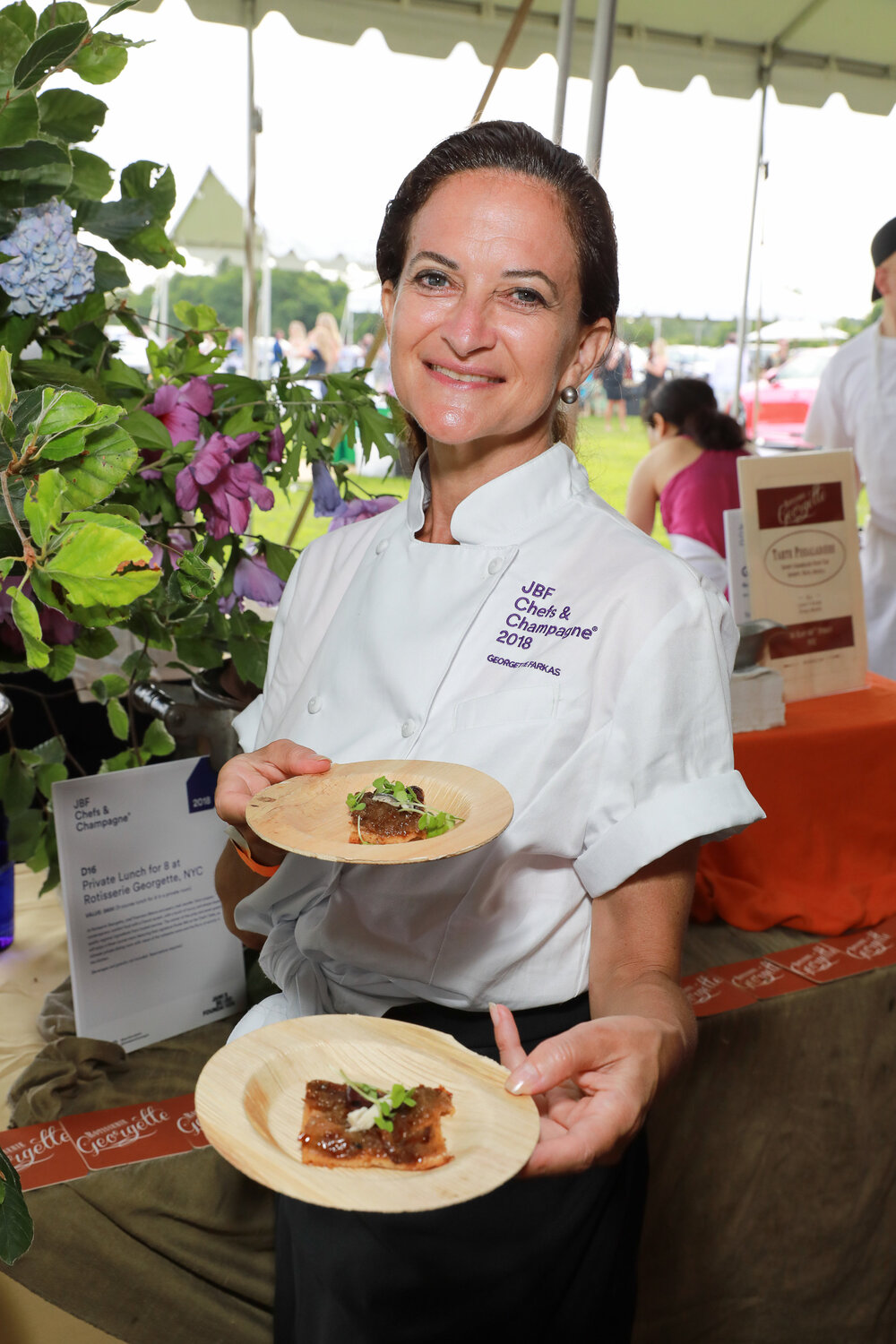

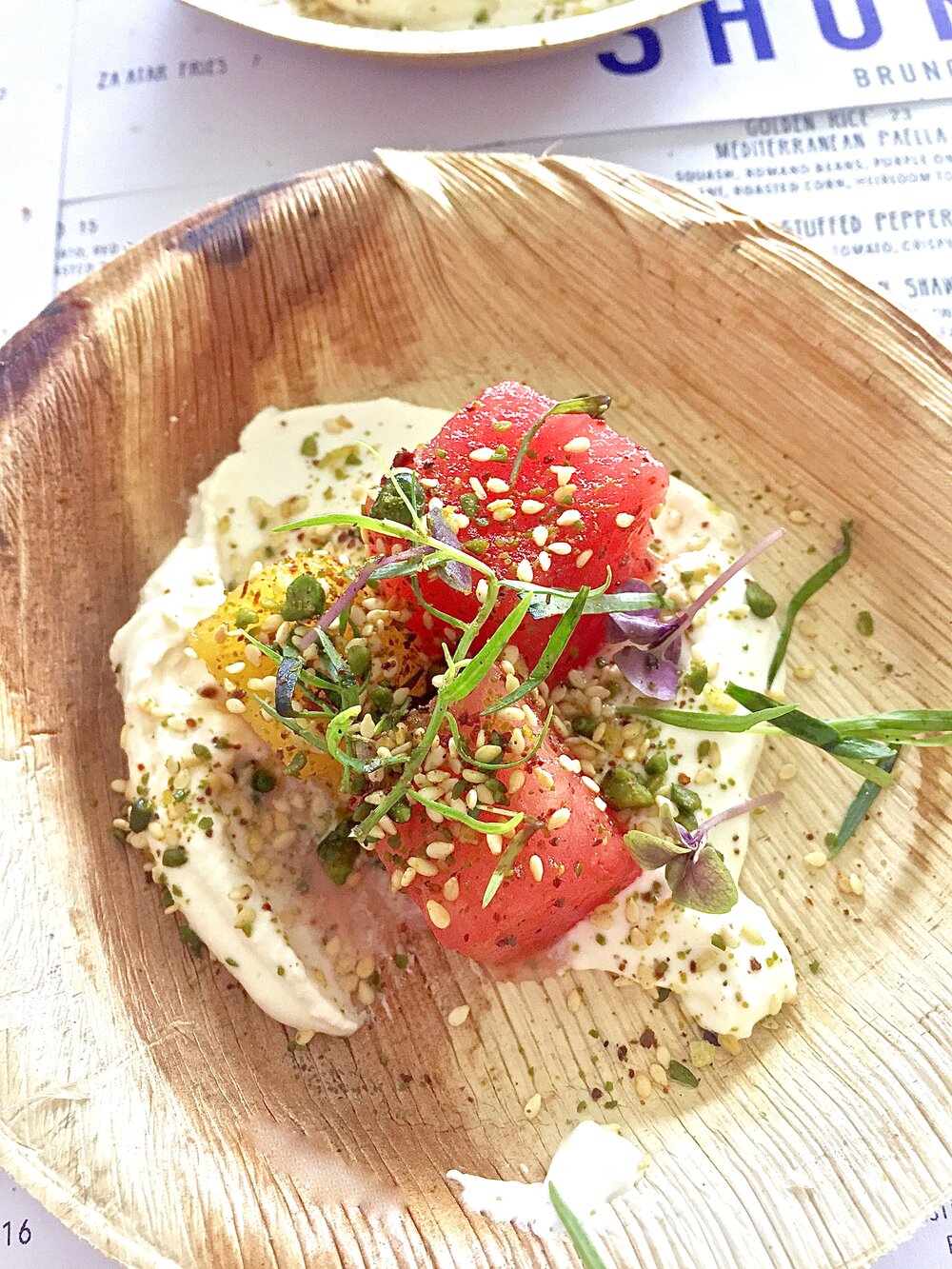
6.) Foie Gras Torchon with Duck Prosciutto, Local Cherries, Rooftop Honey, Farm Blossom + Seed Cracker from Chef Chris Starkus of Urban Farmer in Denver, CO: As a sweet and salty fan, this was a hands down favorite! It led with the salty tang of the prosciutto and finished with the bright, flavorful sweetness of cherries and honey.
7.) 45-Day Dry Aged Certified Angus Beef Rib-eye with Bone Marrow, Bearnaise Sauce + Tomato Confit from Chef Nicole Gajadhar of Saxon + Parole in NYC: Sheer meaty decadence describes this dish in which revelers were offered a choice of sliced, buttery meat or a giant bone robed in an ample lashing of meat and fat - see photo above for my choice!
8.) Wood-Grilled Oysters with Greenneck Butter + Charred Bread from Chefs Janine Booth + Jeff Mcinnis of Root + Bone in NYC and Stiltsville Fish Bar in Miami Beach, FL: This dynamic duo always amazes and we so enjoyed their flavorful oysters served marinating in the decadent butter with bread for handy sopping.
9.) Sweet Corn Sabayon with Blackberry Reduction + Cornmeal Crumble from Chef Claudia Fleming, Chef + Owner of The North Fork Table + Inn in Southold, NY: This masterful dish featured airy, silky/sweet sabayon as the perfect canvas for the flavorful blackberry and delightful texture of the crumble.
10.) Grilled Oregon Albacore with Lemongrass, Galangal, Chile + Lime from Chef Gregory Gourdet of Departure Restaurant + Lounge in Portland, Oregon: This delightful spice and citrus-infused albacore totally popped and provided the perfect vehicle of deliciousness that was also perfectly seasoned.
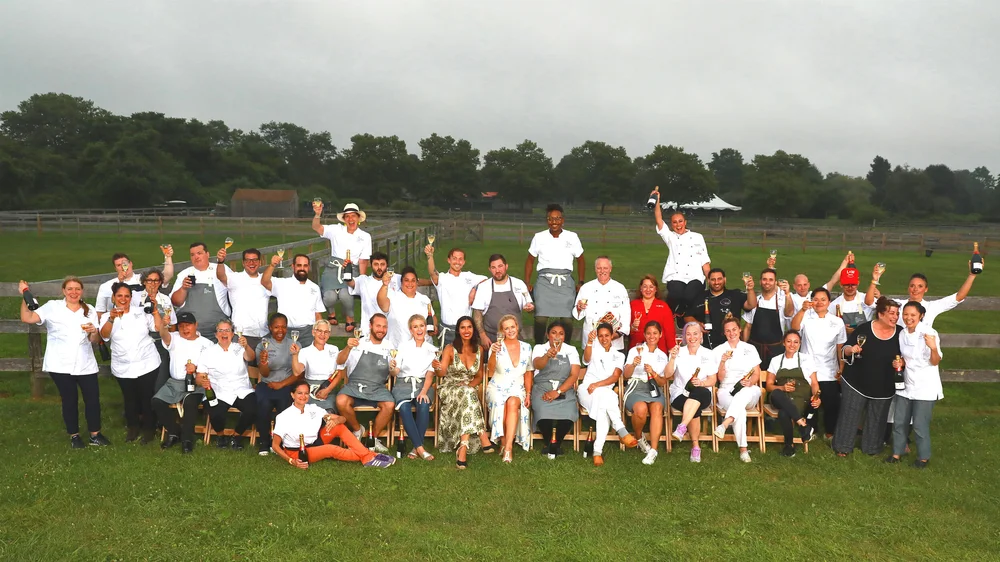
And in keeping with "Chefs & Champagne" tradition, towards the end of the evening, all participating Chefs gathered in the field for a group photo. Cheers to the James Beard Foundation on another fabulous evening - we're already looking forward to next year! Also, to view my posts on previous Chefs & Champagne events, please click here.

Father's Day is this weekend and you know what that means. It's time to show Dad just how much you love him and appreciate ALL he's done for you.Yep, no pressure at all.
And if Dad happens to be a wine lover, shopping for a special gift can be extra intimidating - but never fear! I've got some wonderful Father's Day gift ideas for you that I also recently shared on WPTV with one of Palm Beach Counties favorite Dads, John Favole! These selections are guaranteed to cinch you the coveted title of The Favorite Child.
When it comes to shopping for wine, remember to keep it simple. This is not the time to be delving into the climats of Burgundy and paying hundreds of dollars for a bottle of wine.
Instead, stick with familiar grape names and wine regions that are similar to those you know your Dad already enjoys. And if there's one thing children usually know, it's what Dad likes to drink, right? So whether he reaches for Chardonnay, Pinot Noir or something a little stronger, simply spending a few dollars more for a special bottle can sure make Dad's day and make him feel appreciated.
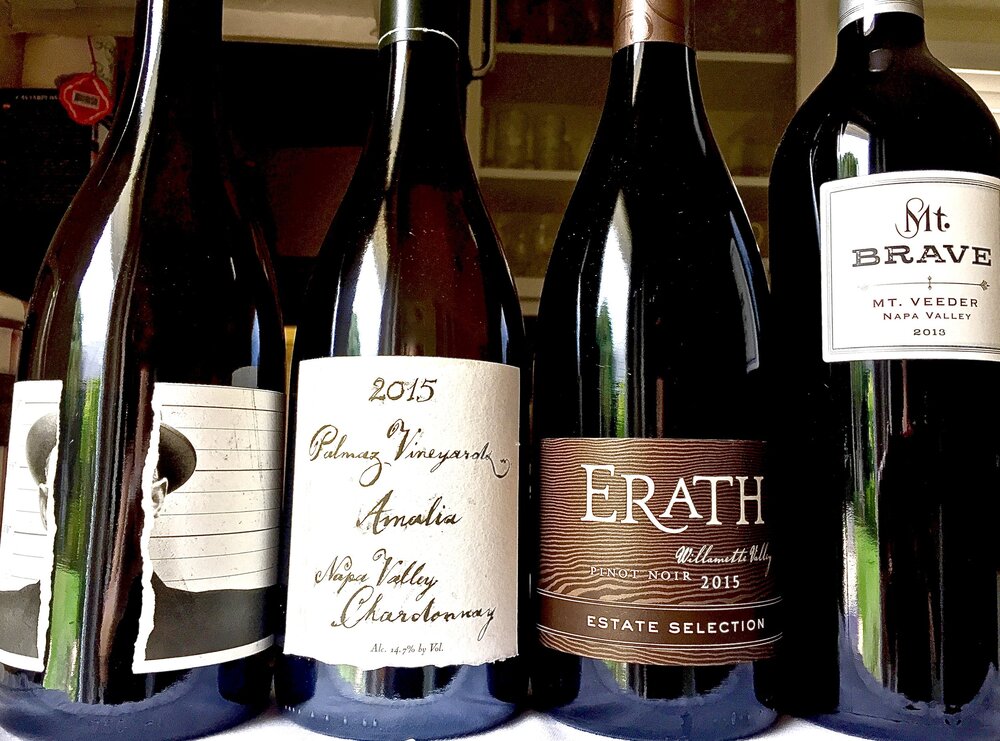
Father's Day Wine Recommendations: These classic bottle are surefire palate pleasers and are also pretty widely available:
1.) The Prisoner Wine Company "The Snitch" Chardonnay, Napa Valley, California ($35): This wine is the latest, limited-edition release from this uber-popular producer. It features Chardonnay blended with a touch of Roussanne for an extra Summery wine with delightfully lively notes of tropical fruit, peach and citrus.
2.) Palmaz Vineyards Amalia Chardonnay, Napa Valley, California ($70): Perfect for the collector, this gorgeous, hand-crafted Napa Valley Chardonnay from the Palmaz family will surely make Dad smile! It's also a fabulous place to visit next time he's traveling out to wine country.
3.) Erath Estate Selection Pinot Noir, Willamette Valley, Oregon ($35): For the Pinot-loving Pop, this wine from one of the Willamette's Valley's most notable producers is a wonderful choice. This Pinot delivers classic notes of cherry, earth and spice crafted solely from estate grown fruit.
4.) Mt. Brave Cabernet Sauvignon Mt. Veeder, Napa Valley, California ($70): If Dad prefers big, bold red wines, this classic Cabernet from renowned winemaker Chris Carpenter is definitely the way to go! Crafted solely from estate, mountain grown fruit, this well-structured Cab features luscious notes of dark fruit, tobacco and spice accompanied by ample, age-worthy tannins.
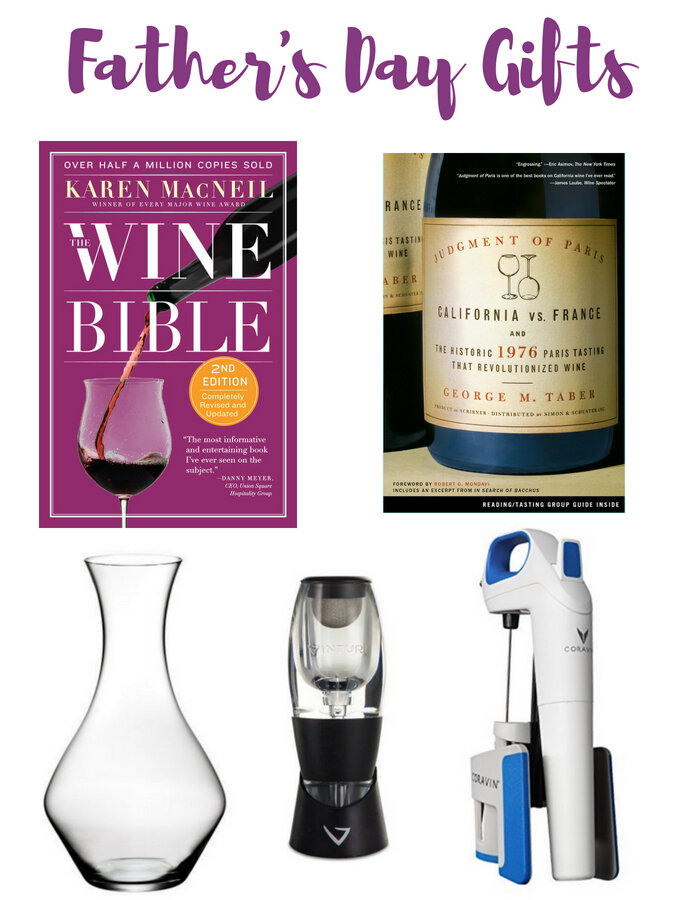
And if Pop has all the Pinot he can handle at the moment, opt for a wine-related accessory or book instead. Or to zhuzh up a bottle of wine, pair it with one of these vinous essentials:
"The Wine Bible" by Karen MacNeil ($17): This book is a must for anyone interested in learning about wine! The completely revised and updated Second Edition was recently released making it the perfect time to snatch this up for Dad.
"Judgement of Paris" by George Taber ($20): The hardcover edition of this book which depicts the legendary wine tasting that pitted California and French wines against one another is a true classic! And who better to tell the story than Taber who was the only reporter there documenting this monumental event that would change the wine world forever...
The Vinturi Essential Red Wine Aerator ($20): Dad can tame those tannins in his next glass of red wine without having to decant the entire bottle with this handy gadget. It transforms wines from tart and astringent to smooth and supple in seconds!
Riedel Magnum Wine Decanter ($67 - marked down from $80 on Amazon!): Perfect for decanting both full-bodied white AND red wines, this beautiful crystal decanter is as practical as it is beautiful. It's ideal for decanting an entire bottle of wine and will have Dad looking like one sophisticated oenophile when entertaining at home!
Coravin Model One Wine Preservation System ($199): This innovative gadget has revolutionized the way we now enjoy and collect wine. A super thin needle inserted through the cork of any wine bottle allows the user to siphon out a glass of wine without disturbing the wine. It's perfect for keeping tabs on that bottle of Bordeaux you've been aging so no more guessing whether a wine is at its prime or not.
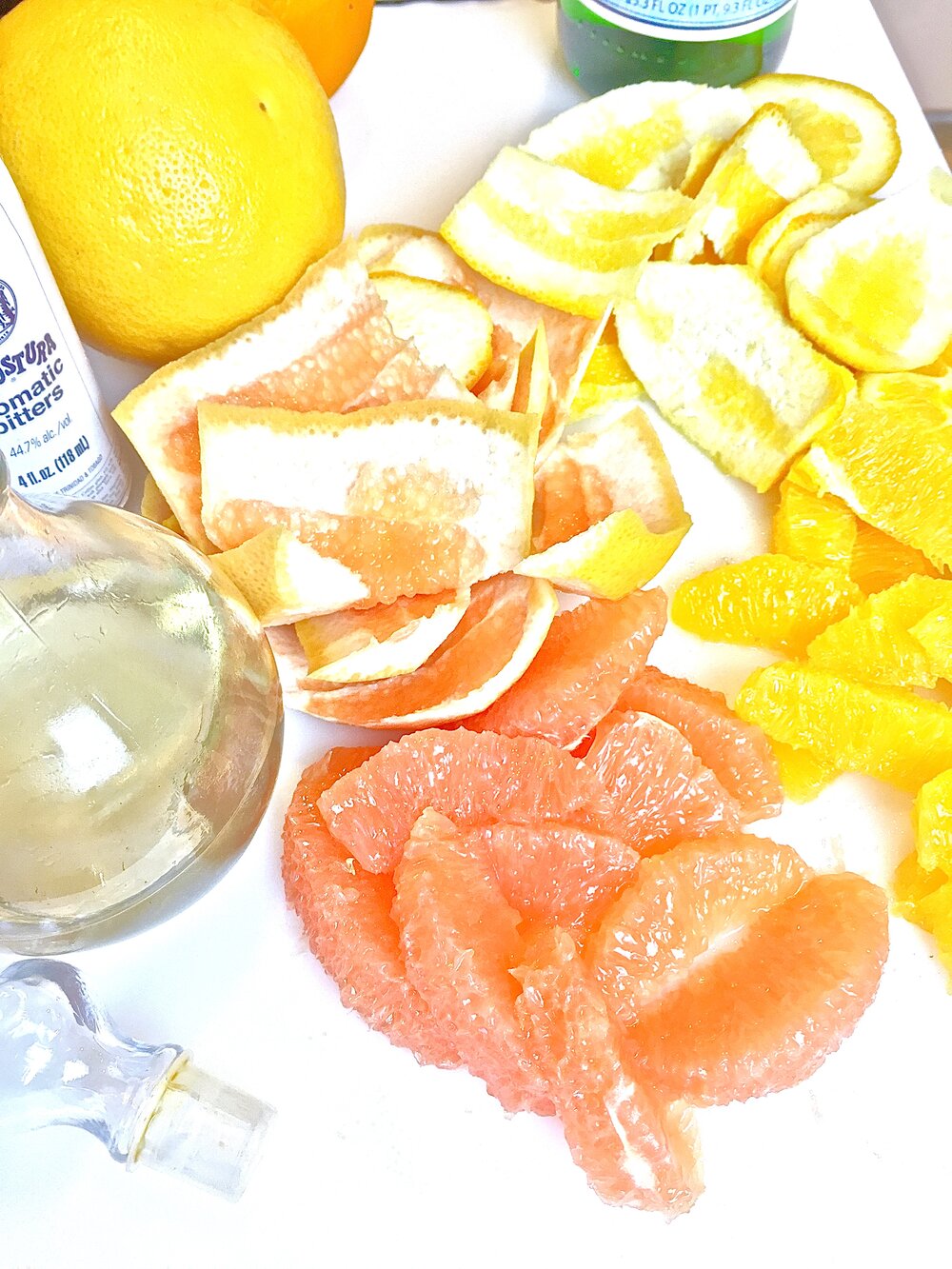
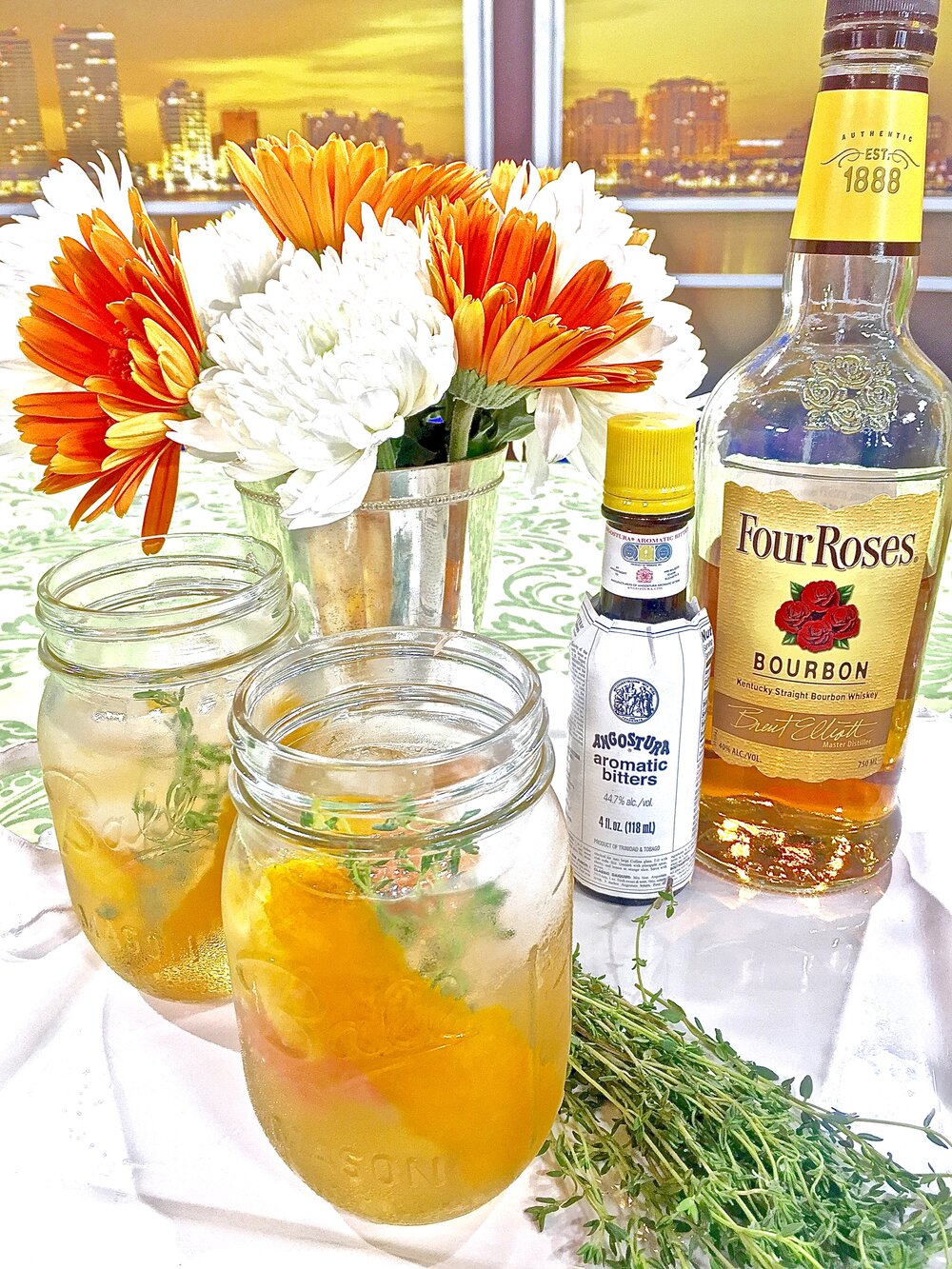
But if Dad's more of a Cocktail Connoisseur, why not surprise him with his own Signature Cocktail? The "Summer Citrus Old Fashioned" is my Summer-infused take on a true classic that is sure to delight him on Father's Day, and quite possibly ALL Summer long.
This delicious cocktail features easy to find ingredients including Bourbon (I like Four Roses Yellow Label Bourbon ($20)), Angostura bitters, sparkling water and oodles of fresh citrus and thyme for garnish. It also calls for lemon thyme simple syrup that is super easy to make (and can conveniently be made a day ahead) that will make you look like a true mixologist!
Please click here to watch the full WPTV segment and simply scroll down for the recipe for the Summer Citrus Old Fashioned. Cheers to all you fabulous Dads out there and I hope you have a very Happy Father's Day!!!
Print Recipe"FATHER'S DAY SUMMER CITRUS OLD FASHIONED"
Author: Stephanie Miskew | The Glamorous Gourmet
Makes: 3-4 drinks
Dad is sure to enjoy this Signature Cocktail on his special day and ALL Summer long!
Ingredients
For Lemon Thyme Simple Syrup:
1 cup sugar
1 cup still water
6-7 sprigs of fresh lemon thyme (if you can't find lemon thyme regular thyme is fine!)
For Cocktail:
1 cup Four Roses Yellow Label Bourbon
2 cups sparkling water
1/4 cup (or to taste) Lemon Thyme Simple Syrup
6-7 dashes Angostura bitters
1 orange, zested into 1" wide x 2-3" long strips for garnish, and then sectioned
1 grapefruit, sectioned
Thyme sprigs for garnish
Cocktail cherries for garnish (optional)
Instructions
To make the lemon thyme simple syrup, add the still water and sugar to a small saucepan. Bring to a boil over medium heat, stirring constantly to dissolve the sugar.
Once sugar is dissolved, remove pan from heat and add the thyme springs. Let steep for about 1 hour. Remove thyme sprigs from the cooled syrup and discard them. Strain the mixture into an airtight container and refrigerate until ready to use.
To make the cocktail, cut orange and grapefruit sections into bite-sized chunks.
Combine the bourbon, bitters, and lemon thyme simple syrup (to taste) in a pitcher. Adjust flavors to taste and then top with sparkling water just before serving.
Add ice cubes to serving glasses and divide chopped citrus among them. Add an orange twist and a few thyme sprigs to each glass and then pour prepared cocktail over ice and serve immediately!

Pssst. I have a secret to tell you. A secret...de fromage! And if you love cheese as much as I do, I hope you can join me for this special episode of "Wines of the Week" on Facebook LIVE featuring fabulous Cheeses of Europe. Entitled, 'Secrets de Fromage,' this show features an exceptional selection of tantalizing cheeses, as well as a wonderful lineup of wines from around the world to pair with them.
And let's face it, from George and Amal to Beyoncé and Jay-Z, some pairings are truly special. They have a sizzling synergy and are simply greater than the sum of their parts. In this episode, I'm also going to share some tips and tricks to help you create exceptional, 1+1=3 wine and cheese pairings at home. Just be ready for your friends and family to start stopping by on a much more regular basis.
So are you ready to dive in?
Please scroll down for the list of featured wines and cheeses mentioned in this episode, but you simply must watch the video below for ALL the juicy details! Also, as promised, links to all the resources mentioned in the show can be found directly below the list of wines and cheeses.
PAIRING PRINCIPLE #1: Pair Cheeses and Wines of Similar Weight & #2: Pair White Wines with Cheese.
GG SERVING TIP: I also love to serve Brie with Braswell's Red Pepper Jelly ($6.95). This delightfully spicy jelly is positively DELICIOUS and the fat in the cheese keeps its heat in check.
PAIRING PRINCIPLE #3: Pair Sparkling Wine with Rich, Salty Cheeses & #4: Pair Wines and Cheeses with Similar Flavors.
GG SERVING TIP: Due to Comté's delightful flavor profile, I love to serve it with Marcona almonds and dried apricots.
PAIRING PRINCIPLE #5: If it Grows Together, it Goes Together!
GG SERVING TIP: Serve this delectable Italian cheese with a drizzle of balsamic glaze and meaty Castelvetrano olives for maximum deliciousness.
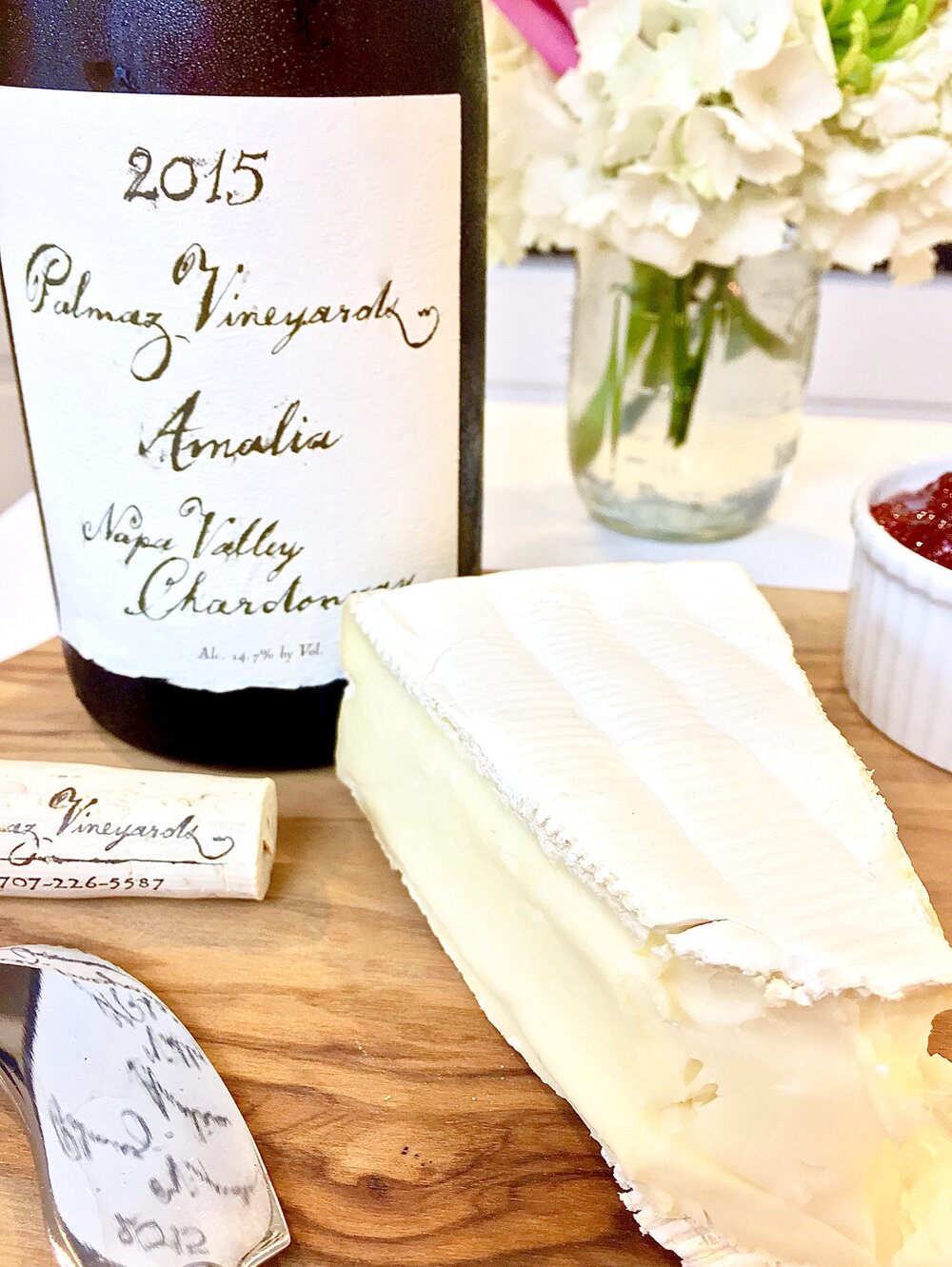
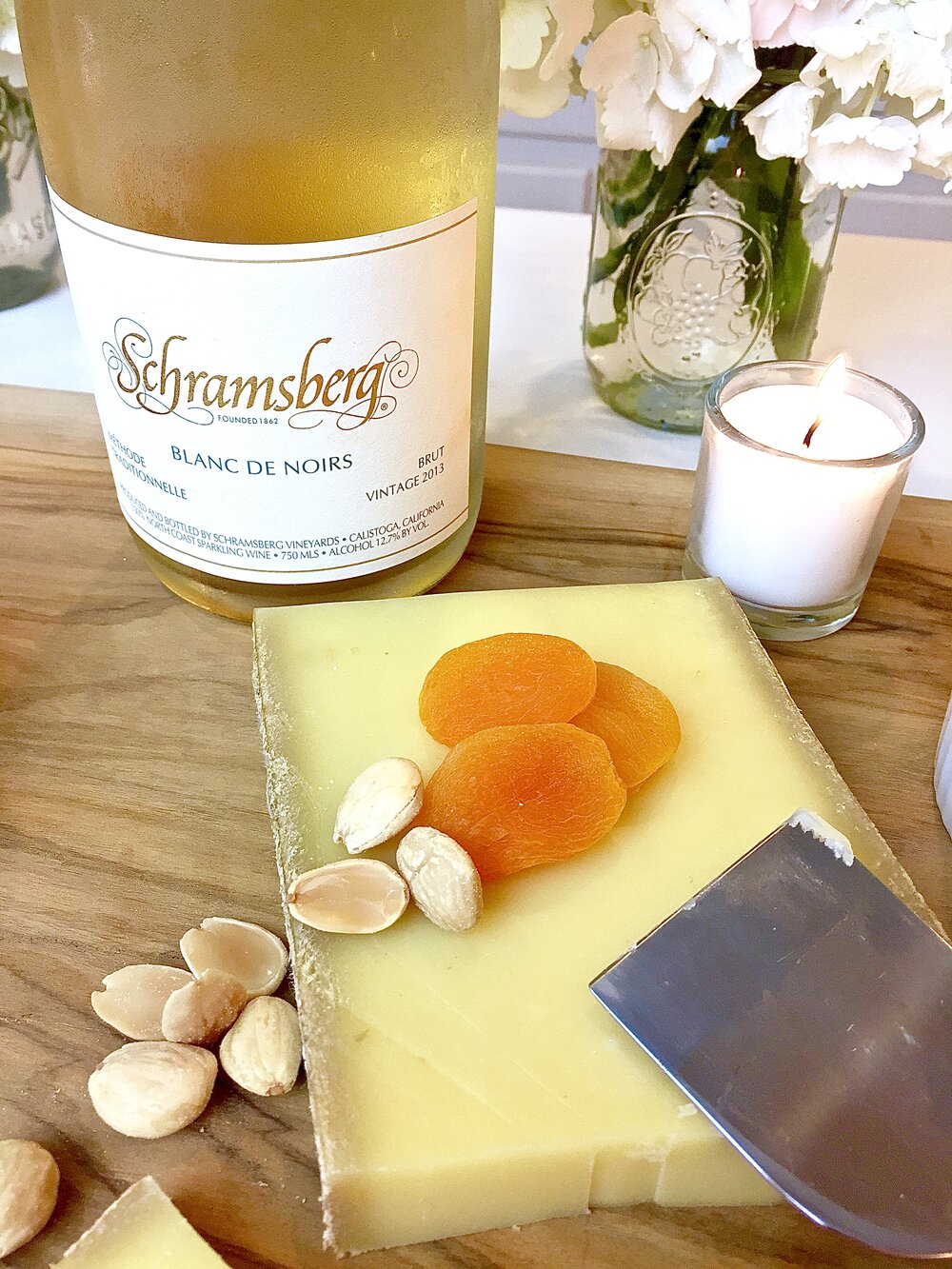
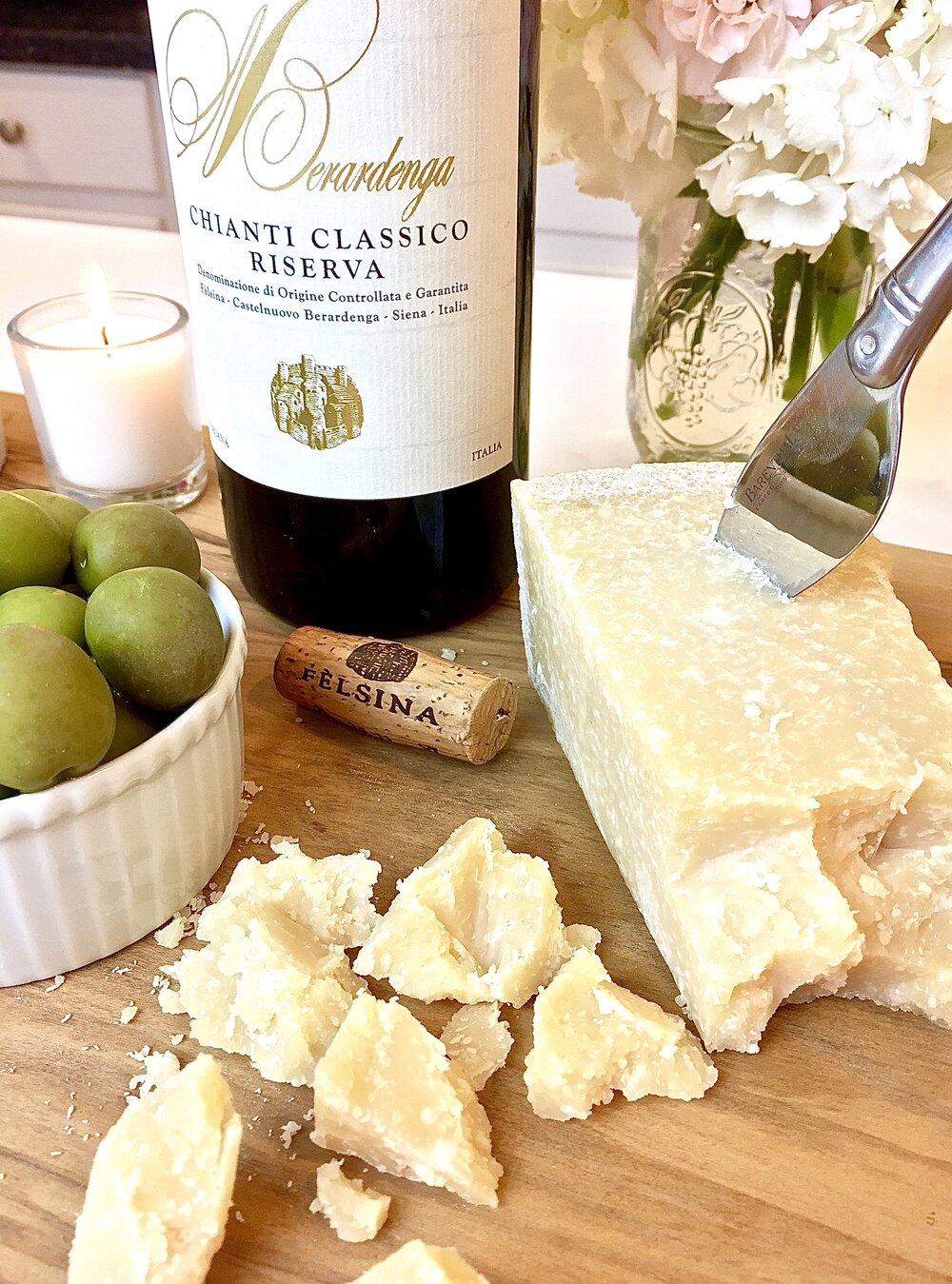
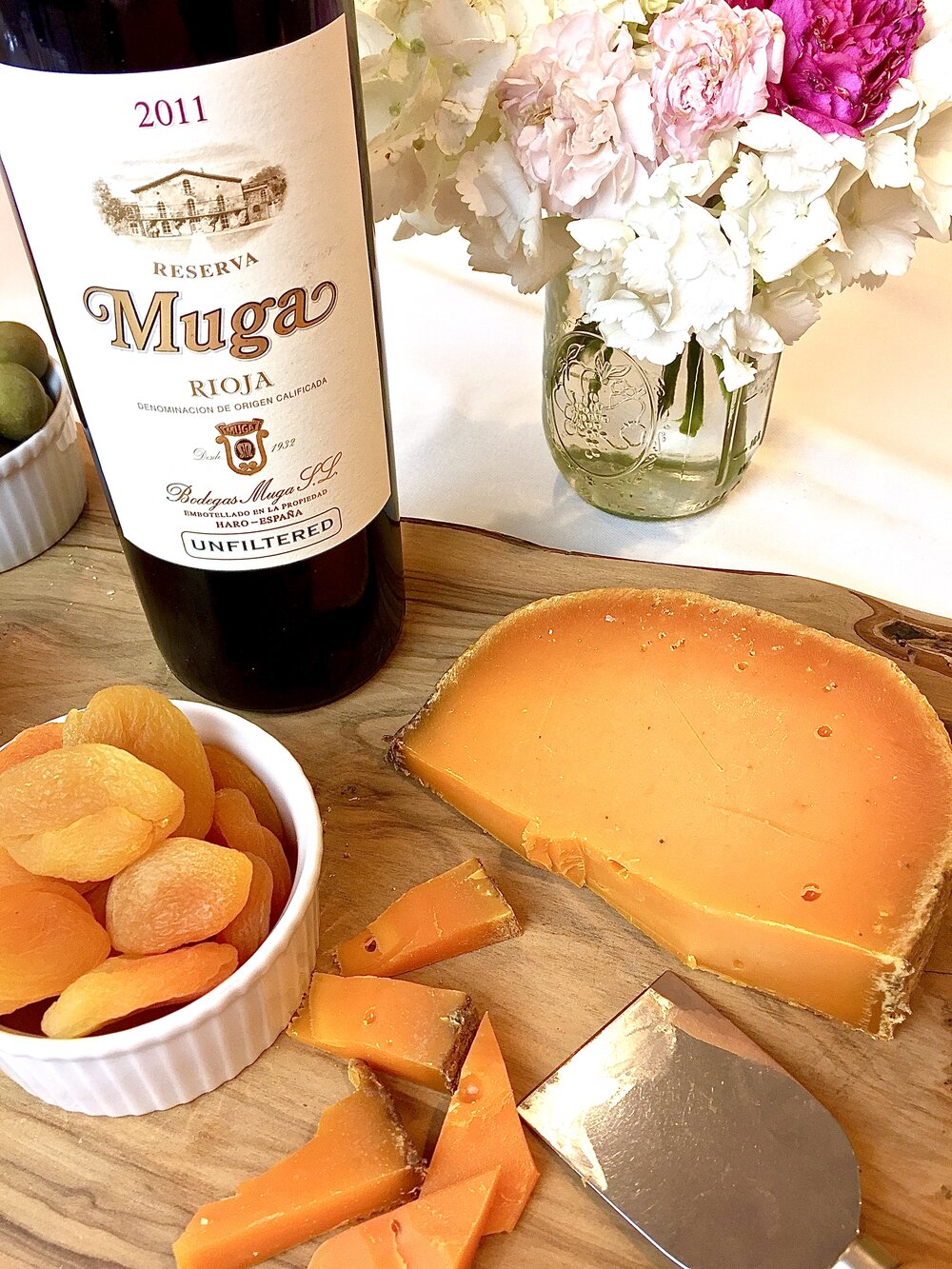
PAIRING PRINCIPLE #6: Pair Red Wines with Hard Cheeses!
GG SERVING TIP: This gorgeous, bright orange hard cheese is complemented by a variety of dried fruit such as apricots, cranberries and figs.
PAIRING PRINCIPLE #7: Pair Cheese and Wine with Opposite Flavors!
GG SERVING TIP: Serve creamy, salty blue cheeses with a generous drizzle of honey for an over the top sweet and salty experience - YUM!
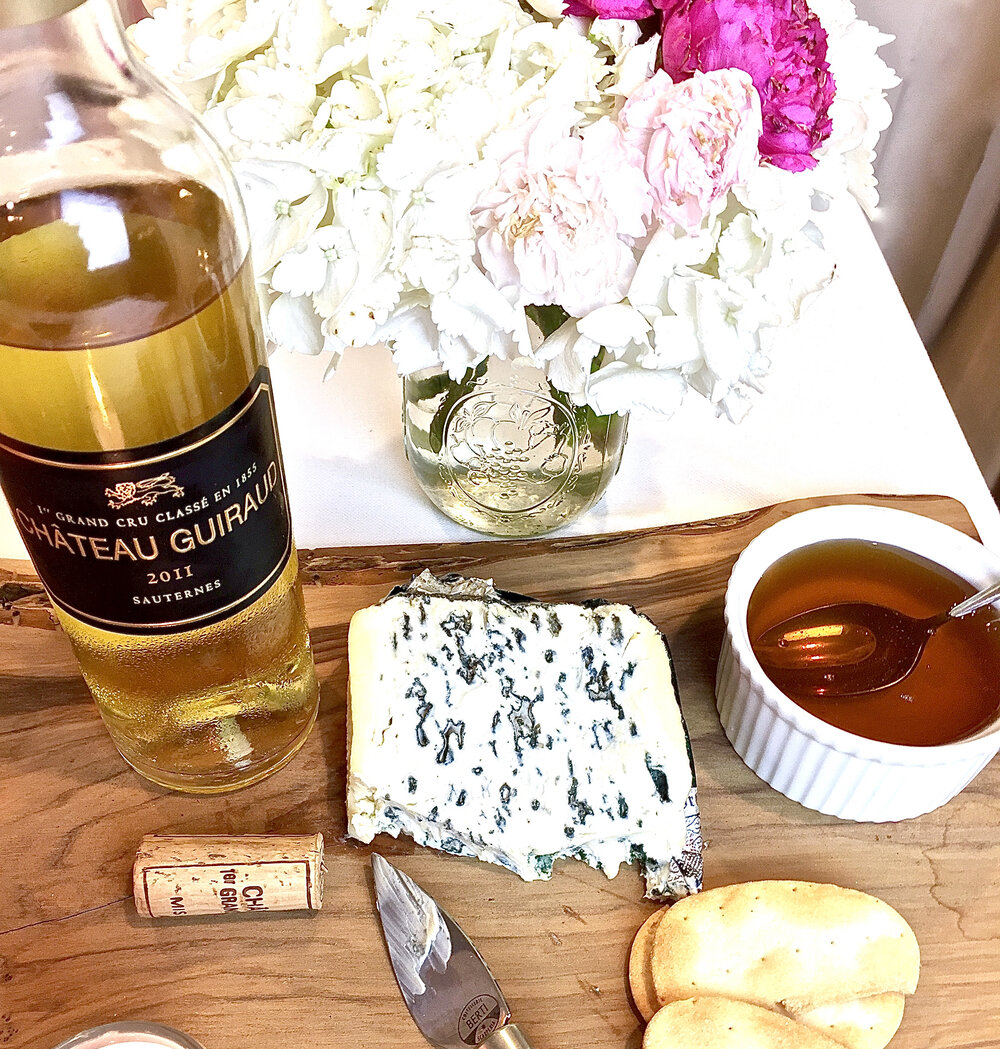
- Learn more about the wine making term, "Sur Lie"
- Click here to go to my Facebook LIVE "Wines of the Week" playlist where you can search for my Italian Wine Month episodes (why can we STILL not share a playlist URL from Facebook, Mark Zuckerbeg?!?)
- Learn more about the wine term "Terroir" I hope you enjoyed this episode of “Wines of the Week” featuring 'Secrets de Fromage' from Cheeses of Europe.
I sure enjoyed sharing these delightful cheeses and wines with you, and I hope you find these pairing principles helpful next time you're entertaining at home. And I'd really love to know what YOUR favorite wine and cheese combinations are so please let me know in the Comments section below.
To view previous episodes of “Wines of the Week,” please click here and enjoy!